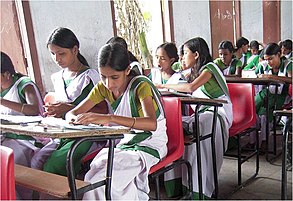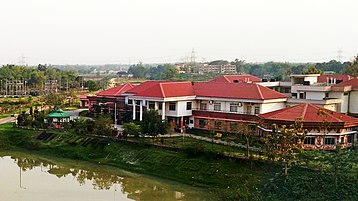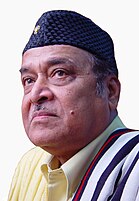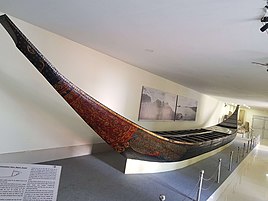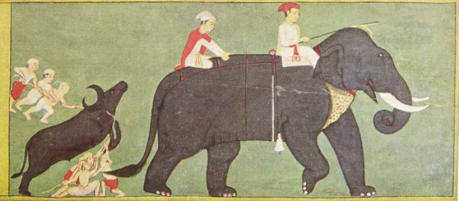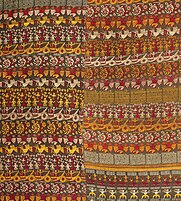Assam
Assam | |
|---|---|
| State of Assam | |
From top, left to right:Indian rhinocerosinKaziranga National Park,Kamakhya Temple,Kareng Ghar,Guwahati Planetarium,IIT Guwahati,Rang Ghar. | |
| Etymology: "A-ham" (Uneven) or from "Ahom" | |
| Nickname(s): "Land of red river and blue hills" | |
| Motto: Joi Aai Axom (Hail Mother Assam)[1] | |
| Anthem:"O Mur Apunar Dekh"(O my Dearest Country) | |
 Location of Assam in India | |
| Coordinates:26°08′N91°46′E/ 26.14°N 91.77°E | |
| Country | |
| Region | Northeast India |
| Before was | State of Assam |
| Bifurcation | 21 January 1972 |
| Formation | 26 January 1950[2] |
| Capital | Dispur |
| Largest city | Guwahati |
| Districts | 35 (5 divisions) |
| Government | |
| • Body | Government of Assam |
| •Governor | Gulab Chand Kataria |
| •Chief minister | Himanta Biswa Sarma(BJP) |
| State Legislature | Unicameral |
| •Assembly | Assam Legislative Assembly(126 seats) |
| National Parliament | Parliament of India |
| •Rajya Sabha | 7 seats |
| •Lok Sabha | 14 seats |
| High Court | Gauhati High Court |
| Area | |
| • Total | 78,438 km2(30,285 sq mi) |
| • Rank | 16th |
| Dimensions | |
| • Length | 725 km (450 mi) |
| • Width | 30 km (20 mi) |
| Elevation | 80 m (260 ft) |
| Highest elevation (Cachar Hills section) | 1,960 m (6,430 ft) |
| Lowest elevation | 45 m (148 ft) |
| Population (2011) | |
| • Total | |
| • Rank | 15th |
| • Density | 397/km2(1,030/sq mi) |
| • Urban | 14.1% |
| • Rural | 85.9% |
| Demonym | Assamese |
| Language | |
| •Official | Assamese[3](for entire state exceptBarak Valley[4])•Boro |
| •Additional official | Meitei(Barak Valley[a]andHojai district)[5]•Bengali(Barak Valley)[4] |
| •Official script | Bengali–Assamese script(forAssamese&Bengali)•Meitei script(forMeitei)•Devanagari(forBodo) |
| GDP | |
| • Total(2024-2025) | |
| • Rank | 18th |
| • Per capita | |
| Time zone | UTC+05:30(IST) |
| ISO 3166 code | IN-AS |
| Vehicle registration | AS |
| HDI(2018) | |
| Literacy(2011) | |
| Sex ratio(2011) | 958 (12th) |
| Website | assam |
| Symbols of Assam | |
 | |
| Song | "O Mur Apunar Dekh"(O my Dearest Country) |
| Foundation day | Assam Day |
| Bird | White-winged duck |
| Flower | Foxtail orchid |
| Fruit | Kaji Nemu |
| Mammal | Indian rhinoceros |
| Tree | Hollong |
| State highway mark | |
 | |
| State highway of Assam AS SH1 -AS SH48 | |
| List of Indian state symbols | |
| • First recognised as an administrative division on 1 April 1911, and led to the establishment ofAssam Provinceby partitioningProvince of East Bengal and Assam. • Assam was one of the original provincial divisions of British India. • Assam has had a legislature since 1937.[9] | |
Assam(/əˈsæm,æˈsæm/ə-SAM,a-SAM,[10][11]Assamese:[ɔ'xɔm]) is a state innortheasternIndia,south of the easternHimalayasalong theBrahmaputraandBarak Rivervalleys. Assam covers an area of 78,438 km2(30,285 sq mi). It is the second largest state innortheastern Indiaby area and the largest in terms of population, with more than 31 million inhabitants. The state is bordered byBhutanandArunachal Pradeshto the north;NagalandandManipurto the east;Meghalaya,Tripura,MizoramandBangladeshto the south; andWest Bengalto the west via theSiliguri Corridor,a 22-kilometre-wide (14 mi) strip of land that connects the state to the rest of India.AssameseandBoroare the official languages of Assam.Meitei(Manipuri) is the official language ofHojai districtand the entirety of theBarak Valleyregion, whileBengaliis an official language in the three districts of Barak Valley.
The state has 35districtswith 5divisions.Guwahati(containing the state capitalDispur) is the largest city innortheastern India.Assam is known forAssam teaandAssam silk.The state was the first site foroil drillinginAsia.[12]Assam is home to the one-hornedIndian rhinoceros,along with thewild water buffalo,pygmy hog,tigerand various species of Asiatic birds, and provides one of the last wild habitats for theAsian elephant.TheAssamese economyis aided bywildlife tourismtoKaziranga National ParkandManas National Park,which areWorld Heritage Sites.Dibru-Saikhowa National Parkis famed for itsferal horses.Sal treeforests are found in the state which, as a result of abundant rainfall, look green all year round. Assam receives more rainfall than most parts of India; this rain feeds theBrahmaputra River,whosetributariesandoxbow lakesprovide the region with a distinctive hydro-geomorphicenvironment.
Etymology[edit]
The first dated mention of the region comes fromPeriplus of the Erythraean Sea(1st century) andPtolemy'sGeographia(2nd century), which calls the regionKirrhadia,apparently after theKiratapopulation.[13][14]In the classical period and up to the 12th century, the region east of theKaratoya river,largely congruent to present-day Assam, was calledKamarupa,and alternatively,Pragjyotisha.[15]Though a western portion of Assam as a region continued to be calledKamrup,theAhom kingdomthat emerged in the east, and which came to dominate the entireBrahmaputra valley,was called Assam (e.g. Mughals usedAsham); and theBritish provincetoo was called Assam. Though the preciseetymology of Assamis not clear, the name Assam is associated with theAhom people,originally calledShyam(Shan).[16]
History[edit]
Pre-history[edit]
Assam and adjoining regions have evidences of human settlement from the beginning of theStone Age.The hills at the height of 1,500 to 2,000 feet (460–615 m) were popular habitats probably due to availability of exposed dolerite basalt, useful for tool-making.[17] Ambarisite in Guwahati has revealedShunga-Kushanaera artefacts including flight of stairs and a water tank which may date from 1st century BCE and may be 2,000 years old. Experts speculate that another significant find at Ambari isRoman eraRoman roulette potteryfrom the 2nd century BCE.[18][19]
Legend[edit]
According to a late text,Kalika Purana(c. 9th–10th centuryCE), the earliest ruler of Assam was Mahiranga Danav of theDanava dynasty,which was removed byNarakaofMithilaand established theBhauma dynasty.The last of these rulers, also Naraka, was slain byKrishna.Naraka's sonBhagadattabecame the king, who (it is mentioned in the Mahabharata) fought for theKauravasin thebattle of Kurukshetrawith an army ofkiratas,chinasand dwellers of the eastern coast. At the same time towards the east in central Assam,Asura Kingdomwas ruled by another line of kings.[20]
Ancient era[edit]
Evidence indicates presence of civilisation in Assam around 2nd century BCE, a rock cut stupa atSri Surya Paharhas been dated to 200 BCE contemporary with rock cutKarleandBhajacaves of Maharashtra. The site is located in a hilly terrain where several rock-cutshivalingas,votive stupas and the deities of Hindu, Buddhist andJainpantheon are scattered.[21]Samudragupta's 4th-century-CEAllahabad pillar inscriptionmentionsKamarupa[22]andDavaka(Central Assam)[23]as frontier kingdoms of theGupta Empire.Davaka was later absorbed by Kamarupa, which grew into a large kingdom that spanned from Karatoya river to near presentSadiyaand covered the entire Brahmaputra valley,North Bengal,parts ofBangladeshand, at timesPurneaand parts ofWest Bengal.[24]The kingdom was ruled by three dynasties who traced their lineage from a mleccha or Kirata Naraka; theVarmanas(c. 350–650 CE), theMlechchha dynasty(c.655–900 CE) and theKamarupa-Palas(c. 900–1100 CE), from their capitals in present-dayGuwahati(Pragjyotishpura), Tezpur (Haruppeswara) andNorth Gauhati(Durjaya) respectively. All three dynasties claimed descent fromNarakasura.In the reign of the Varman king,Bhaskaravarman(c. 600–650 CE), the Chinese travellerXuanzangvisited theregionand recorded his travels. Later, after weakening and disintegration (after the Kamarupa-Palas), the Kamarupa tradition was extended to c. 1255 CE by the Lunar I (c. 1120–1185 CE) and Lunar II (c. 1155–1255 CE) dynasties.[17]
Medieval era[edit]
The Medieval Assam history may have started with the advent ofAhomsin the early part of the 13th century and covers their entire rule of 600 years till 1826. The medieval history of Assam is especially known for its conflict with Muslim powers underTurko-AfghanandMughals,finally resulting in Assamese victory, however, this military glory was shattered in the early 19th century when it failed to resist theBurmese invasions,which led to its annexation.[25]
Chutia Kingdom[edit]
Chutia,aBodo-Kacharigroup by origin, held the regions on both the banks of Brahmaputra with its domain in the area eastwards fromVishwanath(north bank) andBuridihing(south bank), inUpper Assamand in the state ofArunachal Pradesh.It was annexed by the Ahoms in the year 1524. The rivalry between the Chutias and Ahoms for the supremacy of eastern Assam led to a series of conflicts between them from the early 16th century.
Kachari Kingdom[edit]
TheDimasa,anotherBodo-Kacharidynasty, (13th century–1854) ruled fromDikhow Riverto central and southern Assam and had their capital atDimapur.With the expansion of Ahom kingdom, by the early 17th century, the Chutia areas were annexed and since c. 1536 the Kacharis remained only inCacharandNorth Cachar,and more as an Ahom ally than a competing force.
Ahom Kingdom[edit]
Early Period[edit]
TheAhoms,aTaigroup, ruledUpper Assamfor almost 600 years.[26]In the year 1228 the Tai-Ahoms came to theBrahmaputra Valleyunder the leadership ofSukaphaalong with 9,000 men fromMong Mao,a Tai state, situated in South-WesternYunnanof China, and established his kingdom inUpper Assam.In 1253, he founded the capital city in a hillock and named itCharaideo.At the time of his advent, the area was inhabited byMoransand Borahis, to the north, to the north-east was theChutia kingdomand to the south was theKachari kingdomand to the west on the plains were theBaro-Bhuyans.
For more than two and a half centuries, Sukapha and his descendants, while primarily focused on administering the kingdom, upheld their dominance in the valley through their military prowess.[27]
Expansion[edit]

The reign ofSuhungmungmarked the first massive expansion ofAhom kingdom.Besides sending a punitive expeditions against the Nagas, they fought numerous battles with the Bhuyans, Chutias, Kacharis, Turko-Afghans, and the Naras. In 1522-23 theChutia Kingdomwas annexed and the captured tract was placed under the administration of Sadiya-Khowa-Gohain. After securing the eastern tract, Suhungmung than expanded his kingdom westwards through conquest and extended it till Marangi to the west of theDhansiririver. When the Kacharis tried to regain the lost territory they were defeated and their capitalDimapurwas sacked. Over the remaining part of the Kachari kingdom, a new king Detsung was placed as a tributary, but Detsung proved disloyal and revolted against the Ahoms. He was subsequently executed. A new dependent king was set up on the Kachari throne with the name of Nirbhaynarayan. Since then the Kachari kings were regarded as 'thapita sanchita' meaning - established and maintained by the Ahom rulers.
Suhungmung's reign also witnessed the first Muslim-invasions of the kingdom. After a series of battle, the invaders were roundly defeated and were chased up toKaratoya River.The Sultan of Bengal, terrified by the approaching army of Suhungmung, made peace by offering his two daughters and five paraganas, along with other articles as dowry to the king. The rising Koch kingBiswa Singhaalso offered his submission, and the Ahom general Ton-Kham granted him all the territories that were received as dowry from the Sultan of Bengal on the condition of annual tribute.[28]
The successors of Suhungmung,SuklenmungandSukhaamphaa,sent many expeditions against the Bhuyans and Nagas. But were significant with the wars with the Koch. During the reign ofSukhaamphaa,the Ahoms lost to a Koch army led byChilaraiand the Ahoms had to accept Koch supremacy and had to give up the tracts of north of Brahmaputra. However, the lost tract was soon recovered with further military expeditions.[29]
Later Period[edit]
War with Mughals[edit]

Soon after the death ofNara Narayanhis kingdom, got divided between the sons of Nara Narayan andChilaraiasKoch HajoandKoch Bihar.In 1609, Laxmi Narayan king ofCooch Beharaccepted the vassalage ofMughals,and theKoch Hajoking Raghudev and later his son Parikshit sought assistance from Ahoms. In 1612, theMughalsattackedKoch Hajoand his territory up toBarnadi Riverwere annexed in the Mughal domain. This brought the Mughals with direct contact with Ahoms. Meanwhile, Parikshit was trying to renew his friendship with Ahoms, but got captured, and died on his way to his kingdom. LaterBalinarayan,a brother of Parikshit who had taken refugee under the Ahoms was made the king of Darrang in 1615 by the Ahom kingPratap Singha.From 1616, onwards many battles were fought the Mughal without any tangible result, with the firstBattle of Samdharatill after the last battle where the treaty was concluded in 1639 which fixed the Asurar ali on the south bank and the Barnadi on the north bank of the Brahmaputra as the boundary between the two. Pratap Singha had also enacted thePaik systemand created a number of army and civil administration posts such as theBorbaruaandBorphukan.
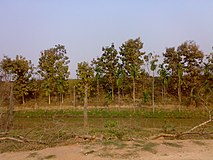
Jayadhwaj Singhataking the advantage ofWar of successionbetween the sons ofShah Jahan,occupied the imperial territories up toDhaka.Aurangzebafter becoming the emperor, appointedMir Jumla II,to recover the lost territory. After fail negotiations. In November 1661, Mir Jumla proceeded with a huge army and fleet to invade Ahom kingdom. Here the Ahoms, lost at several places, and then captured the Ahom capitalGarhgaon.During the rainy season Mir Jumla and his army suffered immeasurable hardship due to the climatic condition of the valley in addition the guerrilla fighting resorted against the invaders. And at last no noticeable gain, negotiation started and in January 1663,Treaty of Ghilajharighatwas concluded. According to the treaty, the Ahoms had to acknowledging Mughal supremacy, ceded the territory west of the Bharali on the north bank and the Kalang on the south bank along with a huge amount of war indemnity and handing over the sons of the Gohains as hostage and two Ahom princesses to the Mughal harem.
Soon after the departure ofMir Jumla,Jayadhwaj Singhadied and the new kingChakradhwaj Singhabegan preparations to overthrow Mughal supremacy and to recover the lost territory. After numerous battles, finally after theBattle of Saraighatthe Mughals were forced to retreat.
The period after 1671 was very unstable due to the rivalry among the nobles, who wanted to arrest their own political power and influence by placing their own choice of prince in the throne. In 1679,Laluksola Borphukan,in hopes of becoming king with the help of Mughals, surrendered Guwahati without any battle. But after the accession ofGadadhar Singha,fought the finalBattle of Itakhuliwhere the Mughals were badly defeated. And the since then the border was fixed at Manah on the north bank and the Nagarbera hill on the south bank of the Brahmaputra till its annexation by theEast India Companyin 1826.[30][31]
18th century[edit]


Rudra SinghasucceededGadadhar Singha,his reign is notable because of his military achievements and his socio-culture contributions. He had both subjugated the Kachari and Jaintia kingdoms, and had captured their kings and forced to accept Ahom suzerainty and agreed them to pay annual tribute. Other than that, several expeditions were sent against the Miris, the Daflas, the Naga Mishmis and the Nagas of Namsung, Dayang and the Rengma Nagas during late 17th century and early 18th century. Rudra Singha had made extensive preparations for his invasion of Bengal but remained unfulfilled due to his sudden death in 1714.
AfterRudra Singha,the Ahoms achieved no notable military achievement. During this period from,Siva SinghatoRajeswar Singha,the kingdom witnessed peace and prosperity and was significant for constructive activities and other development. In the field of religion also,Ekasarana Dharmaspread all over the kingdom and started to influence all aspects of people's life. The religious heads of Vaisnavite monastery exalted great influence with royal patronage and established numerousSatrasand most of the people became their disciples. So got the Ahom court greatly came under the influence of Sakta Brahman priests and astrologers. The religious policies concluded byPhuleshwariand the persecutions of unfavored Satras, embroiled the situation more along with the pressure ofPaik systemin the 18th century.[32]
This finally resulted in theMoamoria rebellion(1769–1805), which greatly weakened theAhom kingdomwhere the country was greatly depopulated and unorganised. The political rivalry between the nobles made a pathway for the Burmese to invade and weakened it more and finally leading to its annexation.
Colonial era[edit]


The discovery ofCamellia sinensisin 1834 in Assam was followed by testing in 1836–37 in London. The British allowed companies to rent land from 1839 onwards. Thereafter tea plantations proliferated in Eastern Assam,[33]where the soil and the climate were most suitable. Problems with the imported Han Chinese labourers from China and hostility from native Assamese resulted in the migration of forced labourers from central and eastern parts of India. After initial trial and error with planting the Chinese and the Assamese-Chinese hybrid varieties, the planters later accepted the localCamellia assamicaas the most suitable variety for Assam. By the 1850s, the industry started seeing some profits. The industry saw initial growth, when in 1861, investors were allowed to own land in Assam and it saw substantial progress with the invention of new technologies and machinery for preparing processed tea during the 1870s.
Despite the commercial success, tea labourers continued to be exploited, working and living under poor conditions. Fearful of greater government interference, the tea growers formed theIndian Tea Associationin 1888 to lobby to retain the status quo. The organisation was successful in this, but even after India's independence, conditions of the labourers have improved very little.[34]
In the later part of the 18th century, religious tensions and atrocities by the nobles led to theMoamoria rebellion(1769–1805), resulting in tremendous casualties of lives and property. The rebellion was suppressed but the kingdom was severely weakened by the civil war. Political rivalry between Prime Minister PurnanandaBurhagohainand Badan ChandraBorphukan,theAhomViceroy of Western Assam, led to an invitation to the Burmese by the latter,[35][36][37][38]in turn leading to three successiveBurmese invasions of Assam.The reigning monarchChandrakanta Singhatried to check the Burmese invaders but he was defeated after fierce resistance, which led to the Burmese occupation of Assam.[39][40][41]
A reign of terror was unleashed by the Burmese on the Assamese people,[42][43][44][45]who fled to neighbouring kingdoms and British-ruledBengal.[46][47]The Burmese reached theEast India Company's borders, and theFirst Anglo-Burmese Warensued in 1824. The war ended under theTreaty of Yandabo[48]in 1826, with the Company taking control of Western Assam and installingPurandar Singhaas king of Upper Assam in 1833. The arrangement lasted until 1838 and thereafter the British gradually annexed the entire region. Thereafter the court language and medium of instruction in educational institutions of Assam was madeBengali,instead of Assamese. Starting from 1836 until 1873, this imposition of a foreign tongue created greater unemployment among thePeople of Assamand Assamese literature naturally suffered in its growth.[49][50]

Initially, Assam was made a part of theBengal Presidency,then in 1906 it was made a part ofEastern Bengal and Assamprovince, and in 1912 it was reconstituted into a chief commissioners' province. In 1913, a legislative council and, in 1937, the Assam Legislative Assembly, were formed in Shillong, the erstwhile capital of the region. The British tea planters imported labour from central India adding to the demographic canvas.
The Assam territory was first separated from Bengal in 1874 as the 'North-East Frontier'non-regulation province,also known as the Assam Chief-Commissionership. It was incorporated into the new province ofEastern Bengal and Assamin 1905 after the partition of Bengal (1905–1911) and re-established in 1912 asAssam Province.[51]
After a few initially unsuccessful attempts to gain independence for Assam during the 1850s, anti-colonial Assamese joined and actively supported theIndian National Congressagainst the British from the early 20th century, withGopinath Bordoloiemerging as the preeminent nationalist leader in the Assam Congress.[citation needed]Bordoloi's major political rival in this time was Sir Saidullah, who was representing theMuslim League,and had the backing of the influential Muslim clericMaulana Bhasani.[52]
TheAssam Postage Circlewas established by 1873 under the headship of the Deputy Post Master General.[53]
At the turn of the 20th century, British India consisted of eight provinces that were administered either by a governor or a lieutenant-governor. Assam Province was one among the major eight provinces of British India. The table below shows the major original provinces during British India covering the Assam Province under the Administrative Office of the Chief Commissioner.
With the partition of India in 1947, Assam became a constituent state of India. TheSylhet Districtof Assam (excluding the Karimganj subdivision) was given up to East Pakistan, which later became Bangladesh.
Modern history[edit]
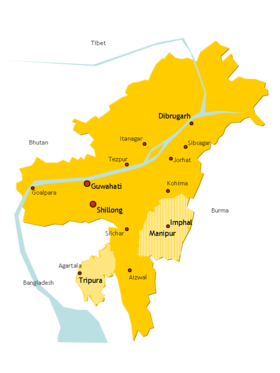
The government of India, which has the unilateral powers to change the borders of a state, divided Assam into several states beginning in 1970 within the borders of what was then Assam. In 1963, the Naga Hills district became the 16th state of India under the name ofNagaland.Part of Tuensang was added to Nagaland. In 1970, in response to the demands of the Khasi, Jaintia and Garo people of theMeghalaya Plateau,the districts containing the Khasi Hills, Jaintia Hills, and Garo Hills were formed into an autonomous state within Assam; in 1972 this became a separate state under the name of Meghalaya. In 1972, Arunachal Pradesh (theNorth East Frontier Agency) and Mizoram (from the Mizo Hills in the south) were separated from Assam as union territories; both became states in 1986.[54]
Since the restructuring of Assam after independence, communal tensions and violence remain.Separatist groupsbegan forming along ethnic lines, and demands for autonomy and sovereignty grew, resulting in the fragmentation of Assam. In 1961, the government of Assam passed legislation making use of theAssamese languagecompulsory. It was withdrawn laterunder pressure from Bengali speaking people in Cachar.In the 1980s the Brahmaputra valley saw a six-yearAssam Agitation[55]triggered by the discovery of a sudden rise in registered voters on electoral rolls. It tried to force the government to identify and deport foreigners illegally migrating from neighbouringBangladeshand to provide constitutional, legislative, administrative and cultural safeguards for the indigenous Assamese majority, which they felt was under threat due to the increase of migration from Bangladesh. The agitation ended after an accord (Assam Accord 1985) between its leaders and the Union Government, which remained unimplemented, causing simmering discontent.[56]
The post 1970s experienced the growth of armed separatist groups such as theUnited Liberation Front of Asom(ULFA)[55]and theNational Democratic Front of Bodoland(NDFB). In November 1990, theGovernment of Indiadeployed theIndian army,after which low-intensity military conflicts and political homicides have been continuing for more than a decade. In recent times, ethnically based militant groups have grown. ThePanchayati RajAct has been applied in Assam, after agitation of the communities due to the sluggish rate of development and general apathy of successive state governments towards Indigenous Assamese communities.[citation needed]
Deadly floods hit the state in2020and2022.[57]
Geography[edit]

A significant geographical aspect of Assam is that it contains three of six physiographic divisions of India – The Northern Himalayas (Eastern Hills), The Northern Plains (Brahmaputra plain) and Deccan Plateau (Karbi Anglong). As the Brahmaputra flows in Assam the climate here is cold and there is rainfall most of the month. Geomorphic studies conclude that the Brahmaputra, the life-line of Assam, is anantecedent riverolder than the Himalayas, which hasentrenched itselfsince they started rising. The river with steepgorgesand rapids in Arunachal Pradesh entering Assam, becomes abraided river(at times 10 mi/16 km wide) and with tributaries, creates a flood plain (Brahmaputra Valley: 50–60 mi/80–100 km wide, 600 mi/1000 km long).[58]The hills ofKarbi Anglong,North Cacharand those in and close to Guwahati (also Khasi-Garo Hills) now eroded and dissected are originally parts of the South Indian Plateau system.[58]In the south, theBarakoriginating in the Barail Range (Assam-Nagaland border) flows through theCachar districtwith a 25–30 miles (40–50 km) wide valley and enters Bangladesh with the nameSurma River.
Urban centres includeGuwahati,one of the 100 fastest growing cities in the world.[59]Guwahati is also referred to as the "Gateway to the North-East India".Silchar,(in the Barak valley) is the second most populous city in Assam and an important centre of business. Other large cities includeDibrugarh,an oil and natural gas industry centre,[60]
Climate[edit]
With thetropical monsoon climate,Assam is temperate (summer max. at 95–100 °F or 35–38 °C and winter min. at 43–46 °F or 6–8 °C) and experiences heavy rainfall and high humidity.[58][61]The climate is characterised by heavy monsoon downpours reducing summer temperatures and affecting foggy nights and mornings in winters, frequent during the afternoons. Spring (March–April) and autumn (September–October) are usually pleasant with moderate rainfall and temperature. Assam's agriculture usually depends on the south-west monsoon rains.
Flooding[edit]
Every year, flooding from the Brahmaputra and other rivers such as Barak River etc. deluges places in Assam. The water levels of the rivers rise because of rainfall resulting in the rivers overflowing their banks and engulfing nearby areas. Apart from houses and livestock being washed away by flood water, bridges, railway tracks, and roads are also damaged by the calamity, which causes communication breakdown in many places. Fatalities are also caused by the natural disaster in many places of the State.[62][63]
Fauna[edit]
Assam is one of the richestbiodiversityzones in the world and consists of tropicalrainforests,[64]deciduous forests, riverinegrasslands,[65]bamboo[66]orchards and numerouswetland[67]ecosystems; Many are now protected as national parks and reserved forests.
Assam has wildlife sanctuaries, the most prominent of which are two UNESCOWorld Heritage Sites[68]-theKaziranga National Park,on the bank of theBrahmaputra River,and theManas Wildlife Sanctuary,near the border with Bhutan. The Kaziranga is a refuge for the fast-disappearing Indian one-horned rhinoceros. The state is the last refuge for numerous other endangered and threatened species including thewhite-winged wood duckordeohanh,Bengal florican,black-breasted parrotbill,red-headed vulture,white-rumped vulture,greater adjutant,Jerdon's babbler,rufous-necked hornbill,Bengal tiger,Asian elephant,pygmy hog,gaur,wild water buffalo,Indian hog deer,hoolock gibbon,golden langur,capped langur,barasingha,Ganges river dolphin,Barca snakehead,Ganges shark,Burmese python,brahminy river turtle,black pond turtle,Asian forest tortoise,andAssam roofed turtle.Threatened species that are extinct in Assam include thegharial,a critically endangered fish-eating crocodilian, and thepink-headed duck(which may be extinct worldwide). For the state bird, the white-winged wood duck, Assam is a globally important area.[clarification needed][69]In addition to the above, there are three other National Parks in Assam namely Dibru Saikhowa National Park, Nameri National Park and the Orang National Park.
Assam has conserved the one-hornedIndian rhinocerosfrom near extinction, along with thepygmy hog,tiger and numerous species of birds, and it provides one of the last wild habitats for theAsian elephant.KazirangaandManasare bothWorld Heritage Sites.The state containsSal treeforests and forest products, much depleted from earlier times. A land of high rainfall, Assam displays greenery. The Brahmaputra River tributaries andoxbow lakesprovide the region with hydro-geomorphicenvironment.[citation needed]
The state has the largest population of thewild water buffaloin the world.[70] The state has the highest diversity of birds in India with around 820 species.[71]With subspecies the number is as high as 946.[72] The mammal diversity in the state is around 190 species.[73]

Flora[edit]
Assam is remarkably rich inOrchidspecies and theFoxtail orchidis the state flower of Assam.[74]The recently established Kaziranga National Orchid and Biodiversity Park boasts more than 500 of the estimated 1,314 orchid species found in India.
Geology[edit]
Assam haspetroleum,natural gas, coal,limestoneand other minor minerals such asmagnetic quartzite,kaolin,sillimanites,clayandfeldspar.[75]A small quantity of iron ore is available in western districts.[75]Discovered in 1889, all the major petroleum-gas reserves are in Upper parts. A recentUSGSestimate shows 399 million barrels (63,400,000 m3) of oil, 1,178 billion cubic feet (3.34×1010m3) of gas and 67 million barrels (10,700,000 m3) ofnatural gas liquidsin the Assam Geologic Province.[76][citation needed]
The region is prone to natural disasters like annual floods and frequent mild earthquakes. Strong earthquakes were recorded in 1869,1897,and1950.
Demographics[edit]
Population[edit]
| Year | Pop. | ±% |
|---|---|---|
| 1901 | 3,289,680 | — |
| 1911 | 3,848,617 | +17.0% |
| 1921 | 4,636,980 | +20.5% |
| 1931 | 5,560,371 | +19.9% |
| 1941 | 6,694,790 | +20.4% |
| 1951 | 8,028,856 | +19.9% |
| 1961 | 10,837,329 | +35.0% |
| 1971 | 14,625,152 | +35.0% |
| 1981 | 18,041,248 | +23.4% |
| 1991 | 22,414,322 | +24.2% |
| 2001 | 26,655,528 | +18.9% |
| 2011 | 31,205,576 | +17.1% |
| Source:Census of India[77] | ||
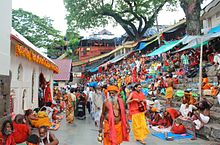
The total population of Assam was 26.66 million with 4.91 million households in 2001.[78]Higher population concentration was recorded in the districts ofKamrup,Nagaon,Sonitpur,Barpeta,Dhubri,Darrang,andCachar.Assam's population was estimated at 28.67 million in 2006 and at 30.57 million in 2011 and is expected to reach 34.18 million by 2021 and 35.60 million by 2026.[79]
As per the 2011 census, the total population of Assam was 31,169,272. The total population of the state has increased from 26,638,407 to 31,169,272 in the last ten years with a growth rate of 16.93%.[80]
Of the 33 districts,Dhubri,Goalpara,Barpeta,Morigaon,Nagaon,andHailakandi,recorded growth rates ranging from 20 per cent to 24 per cent during the last decade, whereasSivasagarandJorhat,registered around 9 per cent population growth. These districts do not have any international border.[81]

In 2011, theliteracyrate in the state was 73.18%. The male literacy rate was 78.81% and the female literacy rate was 67.27%.[80]In 2001, the census had recorded literacy in Assam at 63.3% with male literacy at 71.3% and female at 54.6%. The urbanisation rate was recorded at 12.9%.[82]
The growth of population in Assam has increased since the middle decades of the 20th century. The population grew from 3.29 million in 1901 to 6.70 million in 1941. It increased to 14.63 million in 1971 and 22.41 million in 1991.[78]The growth in theWestern districtsandSouthern districtswas high primarily due to the influx of large number of illegal immigrants fromEast Pakistan,now Bangladesh.[56]
The mistrust and clashes between indigenous Assamese people andBengali Muslimsstarted as early as 1952,[83][84]but is rooted inanti Bengali sentimentsof the 1940s.[85]At least 77 people died[86]and 400,000 people were displaced in the2012 Assam violencebetween indigenousBodosandBengali Muslims.[87]
The People of India project has studied 115 of the ethnic groups in Assam. 79 (69%) identify themselves regionally, 22 (19%) locally, and 3 trans-nationally. The earliest settlers wereAustroasiatic,Dravidianfollowed byTibeto-Burman,Indo-Aryan,andTai–Kadaipeople.[88]Forty-five languages are spoken by different communities, including three major language families: Austroasiatic (5),Sino-Tibetan(24) andIndo-European(12). Three of the spoken languages do not fall in these families. There is a high degree ofbilingualism.[citation needed]
Religions[edit]
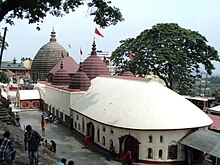
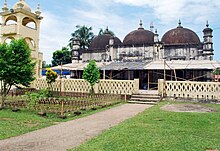
Religion in Assam (2011)[89]

According to the2011 census,61.47% wereHindus,34.22% wereMuslims.[89][90]Christian minorities (3.7%) are found among the Scheduled Tribe and Castes population.[91]The Scheduled Tribe population in Assam is around 13%, of which Bodos account for 40%.[92]Other religions followed includeJainism(0.1%),Buddhism(0.2%),Sikhism(0.1%) andAnimism(amongstKhamti,Phake,Aitonetc. communities).
The three popular sects of Hinduism, namely,Shaivisim,Shaktism,andVaishnavismare prevalent here. Many Assamese Hindus are also followers of theEkasarana Dharmasect ofHinduism.[citation needed]
| Religion | Population |
|---|---|
| Hindus( |
19,180,759 |
| Muslims( |
10,679,345 |
| Christians( |
1,165,867 |
| Buddhists( |
54,993 |
| Jains( |
25,949 |
| Sikhs( |
20,672 |
| Other religions | 27,118 |
| Not stated/available | 50,873 |
| Total | 31,205,576 |
Out of 32 districts of Assam, 9 areMuslimmajority according to the 2011 census of India. The districts areDhubri,Goalpara,Barpeta,Morigaon,Nagaon,Karimganj,Hailakandi,DarrangandBongaigaon.[94][95][96]
Languages[edit]

AssameseandBodoare the official languages of the state,Meitei(Manipuri) is official inHojai districtand all the three districts ofBarak Valley,whileBengaliis official in the three districts ofBarak Valley,[98][4][5]whereSylhetiis most commonly spoken.[99]
| Language | Population |
|---|---|
| Assamese | 15,097,257 |
| Bengali | 9,024,652 |
| Bodo | 1,407,371 |
| Hindi | 1,001,698 |
| Sadri | 714,607 |
| Mishing | 617,870 |
| Nepali | 596,026 |
| Karbi | 511,771 |
| Others | 2,234,319 |
| Total | 31,205,576 |

According to the language census of 2011 in Assam, out of a total population of around 31 million, Assamese is spoken by more than 22 million total speakers, with more than 15 million people speaking it as theirmother tongueand around 7 million asL2 speakers.[100]Although the number of speakers is growing, the percentage of Assam's population who have it as a mother tongue has fallen slightly. Assamese serves aslingua francaof the region[101]as it is spoken by over 71% of the population (including the one who have listed Assamese as their2nd language,[100]while 48.38% of them speak it as their mother tongue.[102]According to the 24th Edition ofEthnologue: Languages of the World,Assamese is spoken by 15,327,990 persons as mother tongue across the world as of 2021.[103]However,2016 Assam Legislative Assembly electionresults, have found that 10 million people speaks Assamese as their mother tongue in Assam, which is significantly fewer than the census result of 2011.[104]The Assamese speakers constituted 48% of the State population according to the 2011 Census.[105][106][107][108]

The variousBengalidialects and closely related languages are spoken by around 9 million people in Assam, and the portion of the population that speaks these languages has grown slightly as per the census. However, the number of Bengali speakers is estimated to be more than the expected census results, as 30% of the of 35% Muslim population in Assam as per 2011 are thought to speak different dialects of Bengali as their native language but during census enumeration, they have reported their mother tongue asAssamese.[109][110][111][112][113]In the Brahmaputra Valley, the main Bengali dialect is that ofMymensingh(now in Bangladesh),[114]while in the Barak Valley and Hojai district,Sylhetiis the main language which is also considered to be a dialect of Bengali in census.[115]Bodois the third most-spoken language followed byHindiwhich comes under fourth position.

The population of the Brahmaputra Valley is 27,580,977 according to the 2011 census report by the Assam government. Assamese is the official language of the Brahmaputra Valley and is spoken by 15 million people comprising 55.65% of the valley population. Bengali is spoken by 6.09 million people representing 22.1% of the valley, Hindi is spoken by 2.1 million comprising 7.61% of the region, Bodo is spoken by 1.41 million comprising 5.13% of the valley's population and 2.98 million people speak various indigenous tribal languages of Assam, such asKarbi,Tiwa (Lalung),Hmar,Deori,Rabha,Mishing,Koch,Rajbangshi,Garo,Dimasa,Gorkha,Halam, Ao and Motak.
Traditionally, Assamese was the language of the common folk in the ancientKamarupa kingdomand in the medieval kingdoms ofDimasa Kachari,Chutiya Kachari,Borahi Kachari,AhomandKamatakingdoms. Traces of the language are found in many poems by Luipa, Sarahapa, and others, inCharyapada(c. 7th–8th century CE). Modern dialects such asKamrupiandGoalpariyaare remnants of this language, which blend into theRajbanshiandRangpurilects spoken in North Bengal which have the same origin. Moreover, Assamese in its traditional form was used by the ethno-cultural groups in the region as lingua-franca, which spread during the stronger kingdoms and was required for economic integration. Localised forms of the language still exist in Nagaland and Arunachal Pradesh.
Linguistically modern Assamese traces its roots to the version developed by the American Missionaries based on the local form used nearSivasagar(Xiwôxagôr) district. Assamese (Ôxômiya) is a rich language due to its hybrid nature and unique characteristics of pronunciation and softness. The presence ofVoiceless velar fricativein Assamese makes it a unique among other similarIndo-Aryan languages.[118][119]
Bodois spoken largely inWestern Assam.It is official language of theBodolandterritorial region and co-official language of the state of Assam. It is also one of twenty-two languages listed in the Eighth Schedule of theConstitution of India.Spatial distribution patterns of the ethno-cultural groups, cultural traits and the phenomenon of naming all the major rivers in theNorth East Regionwith Bodo-Kachari words (e.g.Dihing,Dibru,Dihong,D/Tista,and Dikrai) reveal that it was more widely-spoken in ancient times. Other languages of Tibeto-Burman origin and related to Bodo-Kachari areDeori,Mising,Karbi,Rabha,andTiwa.[citation needed]
There are approximately 590,000Nepalispeakers spread all over the state forming about 1.98% of Assam's total population according to 2011 census.
There are speakers ofTai languagesin Assam. A total of six Tai languages were spoken in Assam. Two are now extinct.[120]
Government and politics[edit]
Assam has GovernorGulab Chand Katariaas the head of the state,[121]theunicameralAssam Legislative Assemblyof 126 members, and a government led by theChief Minister of Assam.The state is divided into five regionaldivisions.
On 19 May 2016,BJPunder the leadership ofSarbananda Sonowalwon the Assembly elections, thus forming the first BJP-led government in Assam.[122]
Administrative districts[edit]

The31 administrative districtsof Assam are delineated based on geographic features such as rivers, hills, and forests.
On 15 August 2015, five new districts were formed:[123][124]
- Part ofSonitpurbecame theBiswanath district(9 in the nearby map)
- Part ofSivasagarbecame theCharaideo district(4)
- Part ofNagaonbecame theHojai district(14)
- Part ofDhubribecame theSouth Salmara-Mankachar district(33)
- TheKarbi Anglong districtwas divided into East (11) and West (15) districts
On 27 June 2016, an island in theBrahmaputra Riverwas bifurcated from theJorhat districtand declared theMajuli district,India's first district that is a river island.[125]
On 12 January 2021,Bajaliwas carved out fromBarpeta districtand formally declared as a district. With the announcement made by GovernorJagdish Mukhi,it has become the 34th district of Assam.[126]
On 31 December 2022, existing four districts Bajali (with Barpeta), Tamulpur(with Udalguri), Biswanath (with Sonitpur) and Hojai(with Nagaon) and number of district came down to 31.
However, after the delimitation exercise was carried out in Assam, theAssam Cabinetreconstituted the 4 new districts (Bajali, Tamulpur, Biswanath and Hojai), taking the number of districts to 35 again.
Subdivisions[edit]
The administrative districts are further subdivided into 54 "Subdivisions" orMahakuma.[124]Every district is administered from a district headquarters with the office of theDeputy Commissioner,District Magistrate, Office of the District Panchayat and usually with adistrict court.
Thelocal governancesystem is organised under thejila-parishad(District Panchayat) for a district,panchayatfor group of or individual rural areas and under the urban local bodies for the towns and cities. There are now 2489 village panchayats covering 26247 villages in Assam.[127]The 'town-committee' ornagar-somitifor small towns, 'municipal board' orpouro-sobhafor medium towns andmunicipal corporationorpouro-nigomfor the cities consist of the urban local bodies.
For revenue purposes, the districts are divided into revenue circles andmouzas; for the development projects, the districts are divided into 219 'development-blocks' and for law and order these are divided into 206 police stations orthana.
Guwahatiis the largestmetropolitan areaandurban conglomerationadministered under the highest form ofurban local body–Guwahati Municipal Corporationin Assam. The Corporation administers an area of 216.79 km2(83.70 sq mi).[128]Apart fromGuwahati Municipal CorporationandDibrugarh Municipal CorporationAll other urban centres are managed underMunicipal Boards.
A list of 9 oldest, classified and prominent, and constantly inhabited, recognised urban centres based on the earliest years of formation of the civic bodies, before theIndian independenceof 1947 is tabulated below:
| Oldest recognised urban centres of Assam[129] | ||||||||
|---|---|---|---|---|---|---|---|---|
| Urban Centres | Civic Body | Year | Airport | Railway Station | Railway Junction | Road Networks | Category† | Notes |
| Guwahati | Guwahati Town Committee | 1853 | Yes | Yes | Yes | Yes | Tier – III | More
Guwahati, the first township of Assam.[130] |
| Guwahati Municipal Board | 1873↑ | Yes | Yes | Yes | Yes | Tier – II | ||
| Guwahati Municipal Corporation | 1974↑ | Yes | Yes | Yes | Yes | Tier – I | More
Establishment of Guwahati Municipal Corporation.[131] | |
| Dibrugarh | Dibrugarh Municipal Board&Dibrugarh Municipal Corporation | 1873 & 2024 | Yes | Yes | Yes | Yes | Tier – II | More
Dibrugarh, the second township of Assam.[132] |
| Goalpara | Goalpara Municipal Board | 1875 | No1 | Yes | No2 | Yes | Tier – II | More
Formation of Goalpara Municipality, 1875.[133] |
| Dhubri | Dhubri Municipal Board | 1883 | Yes | Yes | Yes | Yes | Tier – II | More
Formation of Dhubri Municipality, 1883.[134] |
| Nagaon | Nagaon Municipal Board | 1893 | No3 | Yes | Yes | Yes | Tier – II | More
Formation of Nagaon Municipality, 1893.[135] |
| Tezpur | Tezpur Municipal Board | 1894 | Yes | Yes | Yes | Yes | Tier – II | More
Formation of Tezpur Municipality, 1894.[136] |
| Jorhat | Jorhat Municipal Board | 1909 | Yes | Yes | Yes | Yes | Tier – II | More
Formation of Jorhat Municipality, 1909.[137] |
| Golaghat | Golaghat Municipal Board | 1920 | No4 | Yes | Yes | Yes | Tier – II | More
Formation of Golaghat Municipality, 1920.[138] |
| Silchar | Silchar Municipal Board | 1922 | Yes | Yes | Yes | Yes | Tier – II | More
Formation of Silchar Municipality, 1922.[139] |
| †Tier – I: a big city with anurban conglomeration(in the true sense) administered by aMunicipal corporation.Tier – II: a medium–sized city for anurban agglomerationadministered by aMunicipal Board. Tier – III: a smalltown,larger than atownshipwith a sizeable human settlement. ↑Upgraded to the next highest form of civic body. | ||||||||
Autonomous Council[edit]
The state hasthree autonomous councilsunder the sixth schedule of the Indian Constituition.
- Bodoland Autonomous Territorial Council
- Karbi Anglong Autonomous Council.
- Dima Hasao Autonomous Council.
The state has further statutory autonomous councils constituted under State Act-
- Tiwa Autonomous Councilfor ethnicTiwa people(Lalung)
- Rabha Hasong Autonomous Council
- Mising Autonomous CouncilforMising people
- Deori Autonomous Council
- Sonowal Kachari Autonomous CouncilforSonowal Kachari people
- Thengal Kachari Autonomous Council
- Moran Autonomous Councilfor Moran people
- Dudhnoi for ethnicRabha Kachari
- Mising Autonomous CouncilforMising people
- Matak Autonomous Councilfor Matak people
- Kamatapur Autonomous CouncilforRajbongshi people
- Bodo Kachari Welfare Autonomous CouncilforBodo-Kachari peopleliving outside theBodoland Territorial Region
In March 2024, the Assam cabinet had given green signal for 'Kiran Sheikh' development council for the 'Kiran Sheikh' community inBarak Valley.[140]
Social issues[edit]
Inter-state dispute[edit]

According to Assam Government, Assam has border dispute with four states namely Meghalaya, Mizoram, Nagaland, Arunachal Pradesh.[141]
Assam-Mizoram dispute
Mizoramused to be a district of Assam asLushai hillsbefore being carved out as a separate union territory and later, becoming another state in 1987. Because of the history, the district's borders did not really matter for locals for a long time. Mizoram shares a border with the districtsCachar,HailakandiandKarimganjwhich comes underBarak valleyregion of Assam. Over time, the two states started having different perceptions about where the demarcation should be. While Mizoram wants it to be along anInner Line Permitnotified in 1875 to protect tribals from outside influence, which Mizos feel is part of their historical homeland, Assam wants it to be demarcated according to district boundaries drawn up much later.[141][142]
Assam-Meghalaya dispute
Meghalayahas identified close to a dozen areas on which it has a dispute with Assam about the state's borders. The chief ministers of the two states,Himanta Biswa Sarmaand Megahalya'sConrad Sangma,recently held the first-ever meeting on inter-state border dispute. Both the states have agreed to individually assess the claims for all 12 areas flagged by Meghalaya in the past. A second round of discussion between the two state CMs will be held next month of August. On the question of the role the Union Government is playing in redressing the inter-State border dispute in the country, minister of state for home affairsNityanand Raisaid, "The approach of the Central Government has consistently been that inter-state disputes can be resolved only with the cooperation of the State Governments concerned and that the Central Government acts only as a facilitator for amicable settlement of the dispute in the spirit of mutual understanding."[141]
Assam-Nagaland dispute
The border dispute between the two states has been going on since the formation of Nagaland in 1963. The two states lay claim to Merapani, a small village next to the plains of Assam's Golaghat district. There have been reports of violent clashes in the region since the 1960s.[141][143]
Assam-Arunachal Pradesh dispute
Assam shares an 804.10 km inter-state boundary withArunachal Pradesh.The state of Arunachal Pradesh, created in 1987, claims some land that traditionally belonged to its residents has been given to Assam. A tripartite committee had recommended that certain territories be transferred from Assam to Arunachal. The two states have since been battling it out in theSupreme court of Indiaover the issue. Some incidents of local violence have been reported from the borders.[141][144]
Separate statehood demand within Assam[edit]
Ahomland

Upper Assam's variousTai-Ahomorganisations like "Ahom Tai Mangoliya Rajya Parishad" (ATMRP), has been demanding a separate Ahomland state since 1967, comprising erstwhile Un-divided Sivasagar and Lakhimpur districts (today'sUpper AssamandNorth Assamdivisions) respectively.[145]On 2023, "TAI Ahom Yuba Parishad, Assam" (TAYPA) have organised a protest at Chachal and have demanded separate Ahomland state.[146][147]
Barak state

TheBarak Valleyof Assam comprising the present districts ofCachar,KarimganjandHailakandiis contiguous toSylhet(Bengal plains), where the Bengalis, according to historian J.B. Bhattacharjee, had settled well before the colonial period, influencing the culture ofDimasa Kacaharis.[148][149]Bhattacharjee describes that the Dimasa kings spoke Bengali, the inscriptions and coins were written in Bengali script and the official language of the court was alsoBengali.[149]Migrations to Cachar increased after the British annexation of the region.[149] The nativeBengali peopleof Southern Assam demanded separate state for themselves within the Bengali majority areas of Assam particularly Bengali majorityBarak valleycomprising three districts:Cachar,Hailakandi,Karimganjalong withDima Hasaoand parts ofHojaiwas also demanded to meet the criteria for creating a separate state for themselves by carving out from Assam's Assamese majorityBrahmaputra ValleypostNRC.[150][151][152][153]Silcharis the proposed capital of Barak state.[154]Barak valley is the most neglected part of Assam in terms of its infrastructure development, tourism sector, educational institutions, hospitals, IT industries, G.D.P, H.D.I etc. which is still lagging behind in comparison to the Assam's mainlandBrahmaputra valleywhich have access to all of those facilities mentioned above.[155][156][157][158][159]In fact, the Assam's Southern part have an overall indigenous Bengali majority population, particularlyHojaihave overall (54%) Bengali-speaking population,[160]Barak Valleyregion have an overwhelming Bengali majority of about 80.3%, whileDima Hasaohave approximately 30.2% significant Bengali plurality on certain pockets specially in the urban areas of the district.[116]
Bodoland

The agitation for the creation of a separateBodolandstate resulted in an agreement between the Indian Government, the Assam state government and theBodo Liberation Tigers Force.According to the agreement made on 10 February 2003, theBodoland Territorial Council,an entity subordinate to the government of Assam, was created to govern four districts covering 3082Bodo Kachari-majority villages in Assam.[161][162]Elections to the council were held on 13 May 2003, andHagrama Mohilarywas sworn in as the chief of the 46-member council on 4 June.[163]Demographic wise, the Indigenous Bodo tribe constitutes half of the region's population, along with the region have also significant large number of other ethnic minorities which includes: Assamese, Koch Rajbangshi, Garo, Rabha tribe, Adivasis, Nepalis, Tea tribes, Bengalis, Biharis, Marwaris and Muslims.[116]
Dimaraji

TheDimasa peopleof northeast India have been demanding a separate state calledDimarajior "Dimaland" for several decades. It would comprise theDimasa-Kachariinhabited areas, namelyDima Hasao district,Cachar district,parts ofBarak Valley, Nagaon district,Hojai districtandKarbi Anglong districtin Assam together with part ofDimapur districtinNagaland.
Karbiland

Karbi Anglongis one of the 35districtsof Assam. Karbi Anglong was previously known as Mikir Hills. It was part of the Excluded Areas and Partially Excluded Areas (the present North East India) in British India. The British Indian government had never included this area under their government's jurisdiction. Thereby, no government development work or activity were done, nor any tax levied from the hills including Karbi Anglong. The first memorandum for aKarbihomeland was presented to Governor Reid on 28 October 1940 bySemsonsing Ingtiand Khorsing Terang at Mohongdijua.[164]The Karbi leaders were then, a part of the All Party Hill Leaders' Conference (APHLC) which was formed on 6 July 1960.[165]The movement again gained momentum when the Karbi Anglong District Council passed a resolution demanding a Separate State in 1981. Then again from 1986 through the leadership of Autonomous State Demand Committee (ASDC), demanded Autonomous statehood of Karbi Anglong and Dima Hasao under Article 244(A). In 2002, the Karbi Anglong Autonomous Council passed another resolution to press for the demand of statehood. Several other memoranda were submitted at different times by several organisations. The demand for a separate state turned violent on 31 July 2013 when student demonstrators set government buildings on fire. Following the incident, the elected leaders of Karbi Anglong jointly submitted a memorandum to thePrime Minister of Indiademanding a separate State. Demographic wise, more than half of the Karbi Anglong population is made up of Indigenous Karbi tribe with significant migrants from other parts of India.[116]
Migration from Bangladesh[edit]
Assam has been a major site of migration since thePartitionof the subcontinent, with the first wave being composed largely ofBengali Hindurefugeesarriving during and shortly after the establishment of India and Pakistan (current day Bangladesh was originally part of Pakistan, known asEast Pakistan) in 1947–1951. Between the period of first patches (1946–1951), around 274,455 Bengali Hindu refugees have arrived from what is now called Bangladesh (formerEast Pakistan) in various locations of Assam as permanent settlers and again in second patches between (1952–1958) of the same decade, around 212,545 Bengali Hindus from Bangladesh took shelter in various parts of the state permanently.[166][167]After the1964 East Pakistan riotsmany Bengali Hindus have poured into Assam as refugees and the number of Hindu migrants in the state rose to 1,068,455 in 1968 (sharply after 4 years of the riot).[168]The fourth patches numbering around 347,555 have just arrived afterBangladesh liberation warof 1971 as refugees and most of them being Bengali speaking Hindus have decided to stay back in Assam permanently afterwards.[169]Though the governments of India and Bangladesh made agreements for the repatriation of certain groups of refugees after the second and third waves, a large presence of refugees and other migrants and their descendants remained in the state. Nevertheless, still people of Bangladesh have been immigrating to Assam on regular basis. As per reports, about 635 of Bangladeshi people mostly Hindus, use to immigrate to Assam daily.[170][171]
Besides migration caused by displacement, there is also a large and continual unregulated movement between Assam and neighbouring regions of Bangladesh with an exceptionally porous border. The situation is called a risk to Assam's as well as India's security.[172]The continualillegal entryof people into Assam, mostly fromBangladesh,has caused economic upheaval and social and political unrest.[173][174]During theAssam Movement(1979–1985), theAll Assam Students Union(AASU) and others demanded that government stop the influx ofimmigrantsanddeportthose who had already settled.[175]During this period, 855 people (the AASU says 860) died in various conflicts with migrants and police.[176][177]The 1983 Illegal Migrants (Determination by Tribunal) Act, applied only to Assam, decreed that any person who entered the Assam after Bangladesh declared independence from Pakistan in 1971 and without authorisation or travel documents is to be considered a foreigner, with the decision on foreigner status to be carried out by designated tribunals. In 1985, theIndian Governmentand leaders of the agitation signed theAssam accordto settle the conflict.[175]
The 1991 census made the changing demographics of border districts more visible.[178][175]Since 2010, the Indian Government has undertaken the updating of theNational Register of Citizens for Assam,and in 2018 the 32.2 million residents of Assam were subject to a review of their citizenship.[179]In August 2019, India released the names of the 2 million residents of Assam that had been determined to be non-citizens and whose names had therefore been struck off the Register of Citizens, depriving them of rights and making them subject to action, and potentially leaving some of them stateless, and the government has begun deporting non-citizens, while detaining 1,000 others that same year.[180][181][182]
In January 2019, the Assam's peasant organisationKrishak Mukti Sangram Samiti(KMSS) claimed that there are around 20lakhHindu Bangladeshisin Assam who would become Indian citizens if theCitizenship (Amendment) Billis passed.BJP,however claimed that only eight lakh Hindu Bangladeshis will get citizenship.[183][184][185]According to various sources, the total number of illegal Hindu Bangladeshis is hard to ascertain.[186][187]According to thecensus data,the number of Hindu immigrants have been largely exaggerated.[187]
In February 2020, the Assam Minority Development Board announced plans to segregate illegal Bangladeshi Muslim immigrants from the indigenous Muslims of the state, though some have expressed problems in identifying an indigenous Muslim person. According to the board, there are 1.4croreMuslims in the state, of which 1 crore are of Bangladeshi origin.[188][189][190]A report reveals that out of total 33 districts in Assam, Bangladeshis dominate almost 15 districts of Assam.[191][192][193]
Floods[edit]
In the rainy season every year, the Brahmaputra and other rivers overflow their banks and flood adjacent land. Flood waters wash away property including houses and livestock. Damage to crops and fields harms the agricultural sector. Bridges, railway tracks, and roads are also damaged, harming transportation and communication, and in some years requiring food to be air-dropped to isolated towns. Some deaths are attributed to the floods.[194][195]
Unemployment[edit]
Unemploymentis a chronic problem in Assam. It is variously blamed on poorinfrastructure,limited connectivity, and government policy;[196]on a "poor work culture";[197]on failure to advertise vacancies;[198]and on government hiring candidates from outside Assam.[199]
In 2020 a series ofviolent lynchingsoccurred in the region.
Education[edit]
-
School girls in the classroom, Lakhiganj High School, Assam
-
Academic complex ofIIT Guwahati
Assam schools are run by the Indian government, government of Assam or by private organisations. Medium of instruction is mainly in Assamese, English or Bengali. Most of the schools follow the state's examination board which is called theSecondary Education Board of Assam.All schools underGovernment of Assamare assessed byGunoutsav Assam.Almost all private schools follow theCentral Board for Secondary Education(CBSE),Indian Certificate of Secondary Education(ICSE) andIndian School Certificate(ISC) syllabuses.[citation needed]
Assamese language is the main medium in educational institutions butBengali languageis also taught as a majorIndian language.In Guwahati and Digboi, many Jr. basic schools and Jr. high schools are Nepali linguistic and all the teachers areNepali.Nepaliis included by Assam State Secondary Board,Assam Higher Secondary Education CouncilandGauhati Universityin their HSLC, higher secondary and graduation level respectively. In some junior basic and higher secondary schools and colleges, Nepali teachers and lecturers are appointed.[citation needed]
The capital, Dispur, contains institutions of higher education for students of the north-eastern region.Cotton College,Guwahati, dates back to the 19th century. Assam has several institutions for tertiary education and research.[citation needed]
Universities, colleges and institutions include:
Universities[edit]
- Assam University
- Assam Agricultural University,Jorhat
- Assam Don Bosco University,[200]
- Assam down town University,[201]
- Assam Rajiv Gandhi University of Cooperative Management,(ARGUCOM), Sivasagar
- Assam Science and Technology University,[202]Guwahati
- Assam Women's University,[203]Jorhat
- Bodoland University,[204]Kokrajhar
- Cotton University,Guwahati
- Dibrugarh University,[205]Dibrugarh
- Gauhati University,[206]Guwahati
- Kaziranga University,[207]Jorhat
- Krishnaguru Adhyatmik Vishvavidyalaya
- Krishna Kanta Handique State Open University
- Kumar Bhaskar Varma Sanskrit and Ancient Studies University
- Mahapurusha Srimanta Sankaradeva Viswavidyalaya
- National Law University and Judicial Academy, Assam[208]
- Royal Global University
- Srimanta Sankaradeva University of Health Sciences
- Tezpur University,[209]Tezpur
Medical colleges[edit]
- AIIMS,Guwahati
- Assam Medical College,Dibrugarh
- Gauhati Medical College and Hospital,Guwahati
- Jorhat Medical College and Hospital,Jorhat
- Diphu Medical College and Hospital,Diphu
- Lakhimpur Medical college and Hospital,Lakhimpur
- Silchar Medical College and Hospital,Silchar
- Tezpur Medical College& Hospital,Tezpur
- Fakhruddin Ali Ahmed Medical College,Barpeta
- Nagaon Medical College and Hospital,Nagaon
- Kokrajhar Medical College and Hospital,Kokrajhar
- Dhubri Medical College and Hospital,Dhubri
- Regional Dental College,Guwahati
- Government Dental College,Silchar
Assam has 12 medical colleges at present with 4 more scheduled to be completed by 2026–27.
Engineering and technological colleges[edit]
- Indian Institute of TechnologyinGuwahati[210]
- Indian Institute of Information Technology, Guwahati
- National Institute of Technology, Silchar,[211]
- Assam Engineering College,Guwahati[212]
- Assam Science and Technology University
- Bineswar Brahma Engineering College,Kokrajhar
- Central Institute of Technology,Kokrajhar[213]
- Girijananda Chowdhury Institute of Management and Technology,Guwahati[214]
- Girijananda Chowdhury Institute of Management and Technology,Tezpur
- Institute of Engineering and Technology,Dibrugarh University
- Institute of Science and Technology,Guwahati University
- Jorhat Engineering College,Jorhat[215]
- Jorhat Institute of Science & Technology,Jorhat
- NETES Institute of Technology & Science Mirza,[citation needed]
- Barak Valley Engineering CollegeNiralaKarimganj
- Golaghat Engineering College,Golaghat
Research institutes present in the state include National Research Centre on Pig, (ICAR) in Guwahati,[216]
Economy[edit]
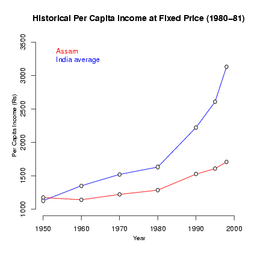
Assam's economy is based on agriculture and oil. Assam produces more than half of India's tea.[217]The Assam-Arakan basin holds about a quarter of the country's oil reserves, and produces about 12% of its total petroleum.[218]According to the recent estimates,[219]Assam's per capita GDP is₹6,157 at constant prices (1993–94) and₹10,198 at current prices; almost 40% lower than that in India.[220]According to the recent estimates,[219]per capita income in Assam has reached₹6756 (1993–94 constant prices) in 2004–05, which is still much lower than India's.

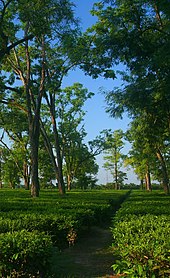
Tea plantations[edit]
Macro-economy[edit]
The economy of Assam today represents a unique juxtaposition of backwardness amidst plenty.[221][full citation needed]Despite its rich natural resources, and supplying of up to 25% of India's petroleum needs, Assam's growth rate has not kept pace with that of India; the difference has increased rapidly since the 1970s.[222]The Indian economy grew at 6% per annum over the period of 1981 to 2000; the growth rate of Assam was only 3.3%.[223]In the Sixth Plan period, Assam experienced a negative growth rate of 3.78% when India's was positive at 6%.[222]In the post-liberalised era (after 1991), the difference widened further.
According to recent analysis, Assam's economy is showing signs of improvement. In 2001–02, the economy grew (at 1993–94 constant prices) at 4.5%, falling to 3.4% in the next financial year.[224]During 2003–04 and 2004–05, the economy grew (at 1993–94 constant prices) at 5.5% and 5.3% respectively.[224]The advanced estimates placed the growth rate for 2005–06 at above 6%.[219]Assam's GDP in 2004 is estimated at $13 billion in current prices. Sectoral analysis again exhibits a dismal picture. The average annual growth rate of agriculture, which was 2.6% per annum over the 1980s, has fallen to 1.6% in the 1990s.[225]The manufacturing sector showed some improvement in the 1990s with a growth rate of 3.4% per annum than 2.4% in the 1980s.[225]For the past five decades, the tertiary sector has registered the highest growth rates of the other sectors, which even has slowed down in the 1990s than in the 1980s.[225]
Employment[edit]
Unemployment is one of the major problems in Assam. This problem can be attributed to overpopulation and a faulty education system. Every year, large numbers of students obtain higher academic degrees but because of non-availability of proportional vacancies, most of these students remain unemployed.[226][227]A number of employers hire over-qualified or efficient, but under-certified, candidates, or candidates with narrowly defined qualifications. The problem is exacerbated by the growth in the number of technical institutes in Assam which increases the unemployed community of the State. Many job-seekers are eligible for jobs in sectors like railways andOil Indiabut do not get these jobs because of the appointment of candidates from outside of Assam to these posts. The reluctance on the part of the departments concerned to advertise vacancies in vernacular language has also made matters worse for local unemployed youths particularly for the job-seekers of Grade C and D vacancies.[228][229]
Reduction of the unemployed has been threatened byillegal immigrationfrom Bangladesh. This has increased the workforce without a commensurate increase in jobs. Immigrants compete with local workers for jobs at lower wages, particularly in construction, domestics, Rickshaw-pullers, and vegetable sellers.[230][231]The government has been identifying (viaNRC) and deporting illegal immigrants. Continued immigration is exceeding deportation.[232][233]
Agriculture[edit]

In Assam among all the productive sectors, agriculture makes the highest contribution to its domestic sectors, accounting for more than a third of Assam's income and employs 69% of workforce.[234]Assam's biggest contribution to the world isAssam tea.It has its own variety,Camellia sinensisvar.assamica.The state produces rice,rapeseed,mustard seed,jute,potato, sweet potato, banana,papaya,areca nut,sugarcane andturmeric.[citation needed]
Assam's agriculture is yet to experience modernisation in a real sense. With implications for food security, per capita food grain production has declined in the past five decades.[235]Productivity has increased marginally, but is still low compared to highly productive regions. For instance, the yield of rice (a staple food of Assam) was just 1531 kg per hectare against India's 1927 kg per hectare in 2000–01[235](which itself is much lower thanEgypt's 9283, US's 7279, South Korea's 6838, Japan's 6635 and China's 6131 kg per hectare in 2001[236]). On the other hand, after having strong domestic demand, and with 1.5 million hectares of inland water bodies, numerous rivers and 165 varieties of fishes,[237]fishing is still in its traditional form and production is not self-sufficient.[238]
Floods in Assam greatly affect the farmers and the families dependent on agriculture because of large-scale damage of agricultural fields and crops by flood water.[62][63]Every year, flooding from the Brahmaputra and other rivers deluges places in Assam. The water levels of the rivers rise because of rainfall resulting in the rivers overflowing their banks and engulfing nearby areas. Apart from houses and livestock being washed away by flood water, bridges, railway tracks and roads are also damaged by the calamity, which causes communication breakdown in many places. Fatalities are also caused by the natural disaster in many places of the state.[239][240]
Infrastructure[edit]
On 30 August 2023, Nilachal Flyover was inaugurated. The flyover is Assam's longest flyover, spanning 2.63 kilometres and connecting Maligaon Chariali to Kamakhya Gate in Guwahati.[241]
Industry[edit]
Handlooms and handicrafts are traditional industries that continue to survive, especially among rural women, in the state.[242]
Assam's proximity to some neighbouring countries such as Bangladesh, Nepal and Bhutan, benefits its trade. The majorBorder checkpointsthrough which border trade flows to Bangladesh from Assam are: Sutarkandi (Karimganj), Dhubri, Mankachar (Dhubri) and Golokanj. To facilitate border trade with Bangladesh, Border Trade Centres have been developed at Sutarkandi andMankachar.It has been proposed in the 11th five-year plan[clarification needed]to set up two more Border Trade Center, one atLedoconnecting China and other atDarrangconnecting Bhutan. There are several Land Custom Stations (LCS) in the state bordering Bangladesh and Bhutan to facilitate border trade.[243]
The government of India has identified some thrust areas for industrial development of Assam:[244]
- Petroleum and natural gas-based industries
- Industries based on locally available minerals
- Processing of plantation crops
- Food processing industries
- Agri-Horticulture products
- Herbal products
- Biotech products
- Pharmaceuticals
- Chemical and plastic-based industries
- Export oriented industries
- Electronic and IT base industries including services sector
- Paper making industries
- Textiles and sericulture
- Engineering industries
- Cane and bamboo-based industries
- Other handicrafts industry
Although, the region in the eastern periphery of India is landlocked and is linked to the mainland by the narrowSiliguri Corridor(or the Chicken's Neck) improved transport infrastructure in all the three modes – rail, road and air – and developing urban infrastructure in the cities and towns of Assam are giving a boost to the entire industrial scene. TheLokpriya Gopinath Bordoloi International Airportat Guwahati, with international flights toBangkokandSingaporeoffered byDruk AirofBhutan,was the 12th busiest airport of India in 2012.[245]The cities of Guwahati[246][247]in the west andDibrugarh[248][249]in the east with good rail,[250][251]road and air connectivity are the two important nerve centres of Assam, to be selected by Asian Development Bank for providing $200 million for improvement of urban infrastructure.[252][253]
Assam is a producer ofcrude oiland it accounts for about 15% of India's crude output,[254]exploited by the Assam Oil Company Ltd.,[255]and natural gas in India and is the second place in the world (afterTitusvillein the United States) where petroleum was discovered. Asia's first successful mechanically drilled oil well was drilled inMakumway back in 1867. Most of the oilfields are located in the Eastern Assam region. Assam has four oil refineries inDigboi(Asia's first and world's second refinery), Guwahati,BongaigaonandNumaligarhand with a total capacity of 7 million metric tonnes (7.7 millionshort tons) per annum. Asia's first refinery was set up at Digboi and discoverer of Digboi oilfield was the Assam Railways & Trading Company Limited (AR&T Co. Ltd.), a registered company of London in 1881.[256]One of the biggest public sector oil company of the countryOil India Ltd.has its plant and headquarters atDuliajan.
There are several other industries, including a chemicalfertiliserplant atNamrup,petrochemicalindustries in Namrup and Bongaigaon, paper mills atJagiroad,Hindustan Paper Corporation Ltd. Township Area PanchgramandJogighopa,sugar mills in Barua Bamun Gaon, Chargola, Kampur, cement plants in Bokajan andBadarpur,and a cosmetics plant ofHindustan Unilever(HUL) atDoom Dooma.Moreover, there are other industries such as jute mill, textile and yarn mills,Assam silk,and silk mills. Many of these industries are facing losses and closure due to lack of infrastructure and improper management practices.[257]
Tourism[edit]
Wildlife, cultural, and historical destinations have attracted visitors.
Culture[edit]

Assamese Cultureis described as ahybridandsyncreticin nature developed due to the assimilation of numerous ethnic groups and cultural practices ofAustroasiatic,Tibeto-Burman,Indo-aryanandTaiinhabitants. Therefore, both local elements or the local elements in Sanskritised forms are distinctly found.[258]The major milestones in the evolution of Assamese culture are:
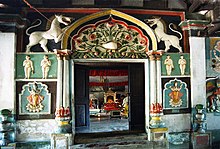
- Assimilation in theKamarupa Kingdomfor almost 800 years (Varman dynastyfor 300 years,Mlechchha dynastyfor 250 years and thePala dynastyfor 200 years.[17]
- Establishment of theChutia kingdomin the 12th century in eastern Assam and assimilation for next 400 years.[17]
- Establishment of theAhom kingdomin the 13th century CE and assimilation for next 600 years.[17]
- Assimilation in theKoch Kingdom(15th–16th century CE) of western Assam and Kachari Kingdom (12th–18th century CE) of central and southern Assam.[17]
- Neo-Vaishanavite (Ekasarana Dharma)Movement led bySrimanta Shankardeva(Xongkordeu) made an enormous impact on the socio-cultural and religious sphere of Assam. This 15th century religio-cultural movement under the leadership ofSrimanta Sankardeva(Xonkordeu) and his disciples have provided another dimension to Assamese culture. A renewed Hinduisation in local forms took place, which was initially greatly supported by the Koch and later by the Ahom Kingdoms. The resultant social institutions such asnamgharandsattra(the Vaishnav Monasteries) have become an integral part of the Assamese way of life. The movement contributed greatly towards language, literature, and performing and fine arts.[citation needed].It was also an egalitarian reform movement as it broke away with the old caste barriers of Brahmanical Hinduism and converted into its fold people of all castes, ethnicity and religions (includingIslam).

The modern culture has been influenced by events in the British and the post-British era.Assameselanguage was standardised by AmericanBaptistMissionariessuch asNathan Brown,Dr. Miles Bronsonand local pundits such asHemchandra Baruawith the dialect spoken in UndividedSibsagarDistrict (the centre of the Ahom Kingdom) forming the standardised dialect.[citation needed]
Increasing efforts of standardisation in the 20th century alienated the localised forms present in different areas and with the less-assimilatedethno-cultural groups(many source-cultures). However, Assamese culture in its hybrid form and nature is one of the richest, still developing and in true sense is a 'cultural system' with sub-systems. Many source-cultures of the Assamese cultural-system are still surviving either as sub-systems or as sister entities, e.g. the;BodoorKarbiorMishing.It is important to keep the broader system closer to its roots and at the same time focus on development of the sub-systems.
Some of the common and unique cultural traits in the region are peoples' respect towardsareca-nutandbetelleaves, symbolic (gamosa,arnai, etc.),traditional silkgarments (e.g.mekhela chador,traditional dress of Assamese women) and towards forefathers and elderly. Moreover, great hospitality and bamboo culture are common.
Symbols[edit]

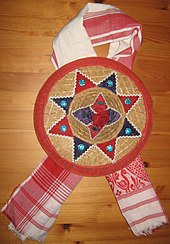
Symbolism is an ancient cultural practice in Assam and is still a very important part of the Assamese way of life. Various elements are used to represent beliefs, feelings, pride, identity, etc.
Tamulpan(areca nut and betel leaves), XoraiandGamosaare three important symbolic elements in Assamese culture.Tamulpanorguapan(gua fromkwa) are considered along with the Gamosa (a typical woven cotton or silk cloth with embroidery) as the offers of devotion, respect and friendship. The Tamulpan-tradition is an ancient one and is being followed since time-immemorial with roots in the aboriginal Austric culture.Xoraiis a traditionally manufactured bell-metal article of great respect and is used as a container-medium while performing respectful offers. Moreover, symbolically many ethno-cultural groups use specific clothes to portray respect and pride.
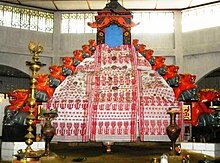
There were many other symbolic elements and designs, but are now only found in literature, art, sculpture, architecture, etc. or in use today for only religious purposes. The typical designs ofAssamese-lion,dragon(ngi-ngao-kham), andflying-lion(Naam-singho) are used for symbolising various purposes and occasions. The archaeological sites such as theMadan Kamdev(c. 9th–10th centuries CE) exhibits mass-scale use of lions, dragon-lions and many other figures of demons to show case power and prosperity.

The Vaishnavite monasteries (Sattras) and many other architectural sites of the late medieval period display the use of lions and dragons for symbolic effects.
Festivals and traditions[edit]



There are diversified important traditional festivals in Assam. Bihu is the most important festival of Assam and is celebrated all over the state.The Assamese new year (Ek Bohag) is celebrated in April of the Gregorian calendar.

Bihuis described as the soul and life of Assam. It is a series of three prominent festivals each associated with a certain stage during the cultivation of paddy. Primarily a secular festival celebrated to mark the seasons and the significant points of a cultivator's life over yearly cycle. Three Bihus,rongali(in the month ofbohag), celebrated with the coming of spring and the beginning of the sowing season;kongaliorkati,the barren bihu when the fields are lush but the barns are empty andbhogali(in the month ofmagh), the thanksgiving when the crops have been harvested and the granaries are full. Bihu songs andBihu danceare associated withrongaliandbhogalibihu. The day before the each bihu is known as the day ofUruka.The first day of 'Rongali bihu' is called 'Goru bihu' (the bihu of the cows), when the cows are taken to the nearby rivers or ponds to be bathed with special care. In recent times the form and nature of celebration has changed with the growth of urban centres.

Bwisaguis one of the most popular seasonal festivals of theBodos.Baisaguis a Boro word which originated from the word "Baisa" which means year or age, and "Agu" meaning starting or beginning. Bwisagu marks the beginning of the new year. It is celebrated at the beginning of the first month of the Boro year, around mid-April in the Gregorian Calendar. It has remarkable similarities to the festival of Rongali Bihu, also celebrated at the same time in Assam. The worship of Bathow is done on the second day of the festival.

Ali-Aye-Ligangor Ali-Ai-Ligang is a spring festivital associated with agriculture celebrated by the indigenousMisingof Assam and other Northeast Indian states. It marks the beginning of the Ahu paddy cultivation in the farms. The term "Ali" denotes legumes, "Aye" means seed and "Ligang" is 'to sow'. The festival is celebrated on a Wednesday of the month of Fagun of the Assamese calendar and in the month of February in English calendar. Thegumragdance is associated with this festival.
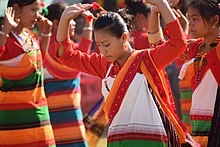
Bushu Dimaor simply Bushu is a major harvest festival of theDimasa people.This festival is celebrated during the end of January. Officially 27 January has been declared as the day of Bushu Dima festival. The Dimasa people celebrate by playing musical instruments- khram (a type of drum), muri (a kind of huge long flute). The people dance to the different tunes of "murithai" and each dance has its own unique name, the most prominent being the "Baidima" There are three types of Bushu celebrated by the Dimasas- Jidap, Surem and Hangsou.

Me-Dam-Me-Phiis the day of theveneration of the dead ancestorsfor theTai-Ahomcommunity. It bears striking similarity in the concept of ancestor worship that the Tai-Ahoms share with other peoples originating from theTaistock. The word ‘Me’ means offerings, ‘Dam’ means ancestors and ‘Phi’ means gods. According to the Buranjis, Lengdon (God of thunder), the king of Mong Phi (The heavenly kingdom), sent two of his grandsons Khunlung and Khunlai to Mong Ri Mong Ram (present dayXishuangbanna,China) and at that moment Ye-Cheng-Pha, the God of knowledge, advised them to perform Umpha, Phuralong, Mae Dam Mae Phi and Rik-khwan rituals in different months of the year on different occasions to pay respect to thePhi-Dam(Ancestral Spirit) and Khwan elements. Since that day till now Mae Dam Mae Phi has been observed by the Tai-Ahoms. It is celebrated on 31 January every year according to the Gregorian calendar.
Rongkeralso calledDehalis an annual winter festival of merriment celebrated by theKarbi peopleof Assam. It is observed in order to appease the local deities associated with the welfare of the village and the harvest of crops and also to get rid of all evil spirits. Although the festival does have a specific time it is usually observed at the beginning of the Karbi New year (Thang thang) which falls on February of the Gregorian calendar.

Doul Mohutsav,also calledFakuwaor Doul Utsav is a festival of colours and happiness popular inLower Assamand especially inBarpeta.It is synonymous with the festival ofHolicelebrated in Northern India. Holigeets of Barpeta are sung which is incredibly popular and enthralls the heart of every Assamese. These holigeets are the exquisite compositions in praise ofLord Krishna.People from different parts of the state visit Barpeta Satra to experience this colourful and joyful festival.
Chavang Kutis a post harvesting festival of theKuki people.The festival is celebrated on the first day of November every year. Hence, this particular day has been officially declared as a Restricted Holiday by the Assam government. In the past, the celebration was primarily important in the religio-cultural sense. The rhythmic movements of the dances in the festival were inspired by animals, agricultural techniques and showed their relationship with ecology. Today, the celebration witnesses the shifting of stages and is revamped to suit new contexts and interpretations. The traditional dances which form the core of the festival is now performed in out-of-village settings and are staged in a secular public sphere. In Assam, the Kukis mainly reside in the two autonomous districts of Dima Hasao and Karbi Anglong.
Beshomais a festival ofDeshi people(one of the indigenousMuslimgroups of Assam).[259]It is a celebration of sowing crop. The Beshoma starts on the last day of Chaitra and goes on until the sixth of Baisakh. With varying locations it is also calledBishmaorChait-Boishne.[260]
Moreover, there are other important traditional festivals being celebrated every year on different occasions at different places. Many of these are celebrated by different ethno-cultural groups (sub and sister cultures). Some of these are:
- Wanshuwa Festival(by theTiwas)
- Kherai(by the Bodos)
- Garja
- Bisu (Deori)
- Awnkham Gwrlwi Janai
- Chojun/Swarak
- Deusi Bhailo ( Traditional Nepalese songs that are sung during the festival of light "Dipavali" and also called "Tihar" )
- Sokk-erroi
- Hacha-kekan
- Hapsa Hatarnai
- Porag
- Bathow
- Wangala
- Bohuwa nrityo

Christmasis observed with great merriment byChristiansof various denominations, includingCatholics,ProtestantsandBaptists,throughout Assam. Durga Pujais widely celebrated across the state. Muslims celebrate two Eids (Eid ul-FitrandEid al-Adha) with much eagerness all over Assam.
Other few yearly celebrations areBrahmaputra Beach Festival,Guwahati,Kaziranga Elephant Festival,Kaziranga andDehing Patkai Festival,Lekhapani, Karbi Youth Festival of Diphu and International Jatinga Festival,Jatingacan not be forgotten. Few yearlyMela'slikeJonbeel Mela,started in the 15th century by the Ahom Kings,Ambubachi Mela,Guwahati etc.
Asom Divas orSukaphaDivas (2 December) is celebrated to commemorate the advent of the first king of theAhom kingdomin Assam after his journey over the Patkai Hills.
LachitDivas (24 November) is celebrated on the birth anniversary of the great Ahom generalLachit Borphukan.Sarbananda Sonowal,the chief minister of Assam took part in the Lachit Divas celebration at the statue of Lachit Borphukan at Brahmaputra riverfront on 24 November 2017. He said, the first countrywide celebration of 'Lachit Divas' would take place in New Delhi followed by state capitals such as Hyderabad, Bangalore and Kolkata in a phased manner.
Music, dance, and drama[edit]
-
Bodo danceBagurumba
-
Jhumair dance in Tea garden
-
Nagara drums
-
Bhupen Hazarika(Music maestro of Assam)
-
Assamese youth performing Bihu Dance
-
Bhaonaperformance
-
Mask making inMajuli

Performing arts include:Ankia Naat(Onkeeya Naat), a traditional Vaishnav dance-drama (Bhaona) popular since the 15th century CE.[citation needed]It makes use of large masks of gods, goddesses, demons and animals and in between the plays aSutradhar(Xutrodhar) continues to narrate the story.[citation needed]
BesidesBihu danceandHusoriperformed during theBohag Bihu,dance forms of tribal minorities such as;Kushan nritraof Rajbongshi's,BagurumbaandBordoicikhladance ofBodos,Mishing Bihu,Banjar Kekanperformed duringChomangkanbyKarbis,JhumairofTea-garden communityare some of the major folk dances.[261]Sattriya(Sotriya) dance related to Vaishnav tradition is a classical form of dance. Moreover, there are several other age-old dance-forms such as Barpeta'sBhortal Nritya,Deodhani Nritya,Ojapali,Beula Dance,Ka Shad Inglong Kardom,Nimso Kerung,etc. The tradition of modern moving theatres is typical of Assam with immense popularity of manyMobile theatregroups such asKohinoor,Sankardev, Abahan, Bhagyadevi, Hengul,Brindabon,Itihas etc.[citation needed]
The indigenous folk music has influenced the growth of a modern idiom, that finds expression in the music of artists likeJyoti Prasad Agarwala,Bishnuprasad Rabha,Parvati Prasad Baruwa,Bhupen Hazarika,Pratima Barua Pandey,Anima Choudhury,Luit Konwar Rudra Baruah,Jayanta Hazarika,Khagen Mahanta,Dipali Barthakur,GanashilpiDilip Sarma, Sudakshina Sarma among many others. Among the new generation,Zubeen Garg,Jitul Sonowal,Angaraag MahantaandJoi Barua.[citation needed] There is an award given in the honour ofBishnu Prasad Rabhafor achievements in the cultural/music world of Assam by the state government.[citation needed]
Cuisine[edit]


Typically, an Assamese meal consists of many things such asbhat(rice) withdayl/ daly(lentils),masor jool(fishstew),mangxô(meatstew) and stir friedgreensorherbsandvegetables.[citation needed]
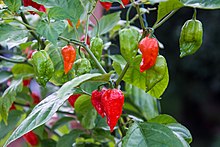
The two main characteristics of a traditional meal in Assam arekhar(an Alkali, named after its main ingredient) andtenga(Preparations bearing a characteristicallyrichandtangyflavour).Khorikais the smoked or fire grilled meat eaten with meals. Pitika (mash) is another delicacy of Assam. It includes alu pitika (mashed potatoes), bilahi (tomatoes), bengena (brinjals) or even masor pitika (fish). Commonly consumed varieties ofmeatincludeMutton,fowl,duck/goose,fish,pigeon,porkandbeef(amongMuslimandChristianindigenous Assamese ethnic groups).Grasshoppers,locusts,silkworms,snails,eels,batwildfowl,squaband other birds,venisonare also eaten, albeit in moderation.[citation needed]

Khorisa(fermentedbamboo shoots) are used at times to flavour curries while they can also be preserved and made into pickles.Koldil(banana flower) andsquashare also used in popular culinary preparations.[262]
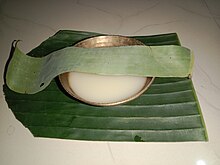
A variety of different rice cultivars are grown and consumed in different ways, viz., roasted, ground, boiled or just soaked.[citation needed]
Fish curries made offree rangewildfishas well asBôralí,rôu,illish,orsitôlare the most popular.[citation needed]
Another favourite combination isluchi(fried flatbread), a curry which can be vegetarian or non-vegetarian.[citation needed]
Many indigenous Assamese communities households still continue to brew their traditional alcoholicbeverages;examples include: Laupani, Xaaj, Paniyo, Jou, Joumai, Hor,Apong,Sujen etc. Such beverages are served during traditional festivities. Declining them is considered socially offensive.[citation needed]
Assamese food is generally served in traditionalbell metaldishes and platters likeKanhi,Maihangand so on.[citation needed]
-
Fish cooked in banana leaves

Literature[edit]
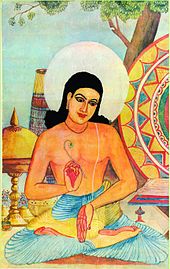
Assamese literature dates back to the composition ofCharyapada,and later on works likeSaptakanda RamayanabyMadhava Kandali,which is the first translation of theRamayanainto anIndo-Aryan language,contributed to Assamese literature.[264][265][266]Sankardeva'sBorgeet,Ankia Naat,BhaonaandSatratradition backed the 15th-16th century Assamese literature.[267][268][269][270]Written during the Reign ofAhoms,theBuranjisare notable literary works which are prominently historical manuscripts.[271]Most literary works are written in Assamese although other local language such asBodoandDimasaare also represented.[citation needed]In the 19th and 20th century, Assamese and other literature was modernised by authors includingLakshminath Bezbaroa,Birinchi Kumar Barua,Hem Barua,Dr. Mamoni Raisom Goswami,Bhabendra Nath Saikia,Birendra Kumar Bhattacharya,Hiren Bhattacharyya,Homen Borgohain,Bhabananda Deka,Rebati Mohan Dutta Choudhury,Mahim Bora,Lil Bahadur Chettri,Syed Abdul Malik,Surendranath Medhi,Hiren Gohainetc.
Fine arts[edit]
The archaicMauryanStupasdiscovered in and aroundGoalpara districtare the earliest examples (c. 300 BCE to c. 100 CE) of ancient art and architectural works. The remains discovered in Daparvatiya (Doporboteeya) archaeological site with a beautiful doorframe in Tezpur are identified as the best examples of artwork in ancient Assam with influence ofSarnathSchool of Art of the lateGuptaperiod.[citation needed]
Painting is an ancient tradition of Assam.Xuanzang(7th century CE) mentions that among the Kamarupa king Bhaskaravarma's gifts toHarshavardhanathere were paintings and painted objects, some of which were on Assamese silk. Many of the manuscripts such asHastividyarnava(A Treatise on Elephants), theChitra Bhagawataand in the Gita Govinda from the Middle Ages bear excellent examples of traditional paintings.[citation needed]
Traditional crafts[edit]
Assam has a rich tradition ofcrafts,Caneand bamboo craft, bell metal andbrasscraft, silk and cottonweaving,toy andmaskmaking,potteryandterracottawork, wood craft,jewellerymaking, and musical instruments making have remained as major traditions.[272]
Cane and bamboo craft provide the most commonly used utilities in daily life, ranging from household utilities, weaving accessories, fishing accessories, furniture, musical instruments, construction materials, etc. Utilities and symbolic articles such asSoraiandBotamade from bell metal and brass are found in every Assamese household.[273][274]HajoandSarthebari(Sorthebaary) are the most important centres of traditional bell-metal and brass crafts. Assam is the home of several types of silks, the most prestigious are: Muga – the natural golden silk, Pat – a creamy-bright-silver coloured silk and Eri – a variety used for manufacturing warm clothes for winter. Apart fromSualkuchi(Xualkuchi), the centre for the traditional silk industry, in almost every parts of the Brahmaputra Valley, rural households produce silk and silk garments with excellent embroidery designs. Moreover, various ethno-cultural groups in Assam make different types of cotton garments with unique embroidery designs and wonderful colour combinations.
Moreover, Assam possesses unique crafts of toy and mask making mostly concentrated in the Vaishnav Monasteries, pottery andterracottawork in western Assam districts and wood craft, iron craft, jewellery, etc. in many places across the region.
-
A page of manuscript painting from Assam; The medieval painters used locally manufactured painting materials such as the colours ofhangool and haitaland papers manufactured from aloewood bark
-
Bell metalmade sorai and sophura are important parts of culture
-
Assam Kahor (Bell metal) Kahi
-
Brihat Ushaharan, an 18th-century manuscript illustration of Garhgoan school of painting
-
Mayurpokhyi Khel-Nao (Pleasure boat) of medieval Assam, used by Badula Ata of Kamalabari Satra
-
18th century Mahisamardini bronze metal sculpture
-
A painting from the folio ofHastividyarnava
-
Mask art of Assam
-
Vrindavani Vastrawas woven in the 16th century under the guidance ofMahapurush Shrimanta Shankardev.The large drape illustrates the childhood activities of Lord Krishna in Vrindavan.
Media[edit]
Print media include Assamese dailiesAmar Asom,Asomiya Khabar,Asomiya Pratidin,Dainik Agradoot,Dainik Janambhumi,Dainik Asam,Gana Adhikar,JanasadharanandNiyomiya Barta.Asom Bani,SadinandJanambhumiare Assamese weekly newspapers. The English dailies of Assam includeThe Assam Tribune,The Sentinel,The Telegraph,The Times of India,The North East Times,Eastern ChronicleandThe Hills Times.Thekar,in the Karbi language has the largest circulation of any daily from Karbi Anglong district.Bodosahas the highest circulation of any Bodo daily from BTR.Dainik Jugasankhais a Bengali daily with editions from Dibrugarh, Guwahati, Silchar and Kolkata.Dainik Samayik Prasanga,Dainik Prantojyoti,Dainik JanakanthaandNababarta Prasangaare other prominent Bengali dailies published in the Barak Valley towns of Karimganj and Silchar. Hindi dailies includePurvanchal Prahari,Pratah KhabarandDainik Purvoday.
Broadcasting stations ofAll India Radiohave been established in 22 cities across the state. Local news and music are the main priority for those stations. Assam has three public service broadcasting service stations of state-ownedDoordarshanat Dibrugarh, Guwahati and Silchar. The Guwahati-based satellite news channels includeAssam Talks,DY 365,News Live,News18 Assam North East,North East Live,Prag NewsandPratidin Time.
See also[edit]
 India portal
India portal- Outline of Assam– comprehensive topic guide listing articles about Assam.
- List of people from Assam
- 2022 Silchar Floods
- Emblem of Assam
Notes[edit]
- ^Barak Valleyhas three districts. In all the three districts,Meitei language(aliasManipuri language) serves as an official language, besides Bengali language.
References[edit]
- ^"State Symbols | Assam State Portal".Assam.gov.in. 1 December 2020.Archivedfrom the original on 4 July 2022.Retrieved24 August2022.
- ^Steinberg, S. (2016).The Statesman's Year-Book 1964–65: The One-Volume ENCYCLOPAEDIA of all nations.Springer. p. 412.ISBN978-0-230-27093-0.Archivedfrom the original on 1 February 2023.Retrieved3 September2018.
- ^"Report of the Commissioner for linguistic minorities: 52nd report (July 2014 to June 2015)"(PDF).Commissioner for Linguistic Minorities, Ministry of Minority Affairs, Government of India. pp. 58–59. Archived fromthe original(PDF)on 28 December 2017.Retrieved16 February2016.
- ^abc"Govt withdraws Assamese as official language from Barak valley".Business Standard India.Press Trust of India. 9 September 2014.Archivedfrom the original on 29 January 2018.Retrieved29 January2018.
- ^abPurkayastha, Biswa Kalyan (24 February 2024)."Assam recognises Manipuri as associate official language in four districts".Hindustan Times.Archivedfrom the original on 25 February 2024.Retrieved26 February2024.
- ^"Assam Budget 2021".16 July 2021. Archived fromthe originalon 17 July 2021.Retrieved17 July2021.
- ^"Sub-national HDI – Area Database – Global Data Lab".hdi.globaldatalab.org.Archivedfrom the original on 23 September 2018.Retrieved13 September2018.
- ^"Census 2011 (Final Data) – Demographic details, Literate Population (Total, Rural & Urban)"(PDF).planningcommission.gov.in.Planning Commission, Government of India. Archived fromthe original(PDF)on 27 January 2018.Retrieved3 October2018.
- ^"Assam Legislative Assembly - History".Archivedfrom the original on 13 September 2016.Retrieved14 September2016.
- ^"Assam".Merriam-Webster.com Dictionary.Retrieved3 August2020.
- ^"Assam".LexicoUK English Dictionary.Oxford University Press.Archived fromthe originalon 7 January 2020.
- ^"Here is India's oil story".The Financial Express.3 May 2018.Archivedfrom the original on 21 July 2019.Retrieved21 July2019.
- ^Besatiain the Schoff translation and also sometimes used by Ptolemy, they are a people similar to Kirradai and they lived in the region between "Assam and Sichuan" (Casson 1989,pp. 241–243)
- ^"ThePeriplus of the Erythraen Sea(last quarter of the first century A.D) and Ptolemy'sGeography(middle of the second century A.D) appear to call the land including Assam Kirrhadia after its Kirata population. "(Sircar 1990:60–61)
- ^"Prior to the thirteenth century the present region was called Kāmarūpa or, alternatively, Prāgjyotiṣapur", Lahiri, Nayanjot.,Pre-Ahom Assam(Delhi 1991) p. 14
- ^"Ahoms also gave Assam and its language their name (Ahomand the modernɒχɒm'Assam' come from an attested earlier formasam,acam,probably from a Burmese corruption of the wordShan/Shyam,cf.Siam:Kakati 1962; 1-4). "(Masica 1993,p. 50)
- ^abcdefSircar, D C (1990), "Pragjyotisha-Kamarupa", in Barpujari, H K (ed.),The Comprehensive History of Assam,vol. I, Guwahati: Publication Board, Assam, pp. 59–78
- ^"The Assam Tribune Online".www.assamtribune.com.Archivedfrom the original on 27 January 2016.Retrieved3 January2019.
- ^"Relics hold clue to missing history – Sunga-Kushana era terracotta artefacts may say if Guwahati existed before 7th century AD".www.telegraphindia.com.Archivedfrom the original on 4 January 2019.Retrieved3 January2019.
- ^India History Association. Session (2001),Proceedings of North East India History Association North Easthe came under the 'bad' influence of Banasura, ruler of Sonitapura (identified with Tezpur now under Sonitpur district in central Assam), and ended up sidelining Kamakhya in favour of Siva. Thereafter Naraka forsook the guidance
- ^Barman, Bratatee (January 2020)."Archaeology of BCE 200 -CE 1200 Assam (Northeast India): Pre-literary to Historical and Early Medieval Periods".Archaeology in Northeast India Recent Trends and Future Prospects Essays Celebrating 150 Years of Research.Archivedfrom the original on 27 April 2022.Retrieved14 August2021.
- ^Tej Ram Sharma,1978, "Personal and geographical names in the Gupta inscriptions. (1.publ.)", Page 254, Kamarupa consisted of the Western districts of the Brahmaputra valley which being the most powerful state.
- ^Suresh Kant Sharma, Usha Sharma – 2005, "Discovery of North-East India: Geography, History, Culture,... – Volume 3", Page 248, Davaka (Nowgong) and Kamarupa as separate and submissive friendly kingdoms.
- ^The eastern border of Kamarupa is given by the temple of the goddess Tamreshvari (Pūrvāte Kāmarūpasya devī Dikkaravasini inKalika Purana) near present-day Sadiya. "...the temple of the goddess Tameshwari (Dikkaravasini) is now located at modern Sadiya about 100 miles to the northeast of Sibsagar" (Sircar 1990,pp. 63–68).
- ^(Baruah 1986:36)
- ^Banikanta Kakati,Assamese:Its formation and development
- ^(Baruah 1986:220–224)
- ^(Baruah 1986:224–234)
- ^(Gogoi 2017:1–17)
- ^"In the Battle of Itakhuli in September 1682, the Ahom forces chased the defeated Mughals nearly one hundred kilometers back to the Manas river. The Manas then became the Ahom-Mughal boundary until the British occupation."Richards, John F. (1995).The Mughal Empire.Cambridge: Cambridge University Press. p. 247.ISBN0521566037.Archivedfrom the original on 1 February 2023.Retrieved26 January2013.
- ^(Gogoi 2017:17–20)
- ^(Gogoi 2017:20–26)
- ^Roy, Tirthankar (2012).India in the World Economy: From Antiquity to the Present.Cambridge University Press. p. 202.ISBN978-1-107-00910-3.
- ^MacFarlane, Alan; MacFarlane, Iris (2003),Green Gold, The Empire of Tea, Ch. 6–11,Random House, London
- ^Gait E.A. A History of Assam 1926 Calcutta and Shimla Thacker & Co page 225
- ^Bhuyan Dr. S.K. Tunkhungia Buranji or A History of Assam (1681–1826) 1968 page 199
- ^Barbaruah Hiteswar Ahomar-Din or A History of Assam under the Ahoms 1981 page 299
- ^Barua Gunaviram Assam Buranji or A History of Assam 2008 page 108
- ^Gait E.A. A History of Assam 1926 Calcutta and Shimla Thacker & Co page 230
- ^Bhuyan Dr. S.K. Tunkhungia Buranji or A History of Assam (1681–1826) 1968 page 206
- ^Barbaruah Hiteswar Ahomar-Din or A History of Assam under the Ahoms 1981 page 320
- ^Gait E.A. A History of Assam 1926 Calcutta and Shimla Thacker & Co page 231
- ^Bhuyan Dr. S.K. Tunkhungia Buranji or A History of Assam (1681–1826) 1968 page 207
- ^Barbaruah Hiteswar Ahomar-Din or A History of Assam under the Ahoms 1981 page 318
- ^Barua Gunaviram Assam Buranji or A History of Assam 2008 page 116-117
- ^Gait E.A. A History of Assam 1926 Calcutta and Shimla Thacker & Co page 232
- ^Barua Gunaviram Assam Buranji or A History of Assam 2008 page117
- ^Aitchison, C. U., ed. (1931),The Treaty of Yandaboo, (A Collection of Treaties, Engagements and Sanads: Relating to India and Neighbouring Countries. Vol. XII.),Calcutta: Projectsouthasia.sdstate.edu, pp. 230–233, archived fromthe originalon 2 December 2008
- ^Barpujari, H.K. (1998).North-East India, Problem Prospect and Politics.Guwahati: Spectrum Publishers. p. 41.
- ^Bose, M.L. (1989).Social History of Assam.New Delhi: Ashok Kumar Mittal Concept Publishing Company. p. 91.
- ^William Cooke Taylor,A Popular History of British India.p. 505
- ^Nath, Sunil (2001)."The Secessionist Insurgency and the Freedom of Minds".www.satp.org.Institute for Conflict Management.Archivedfrom the original on 17 April 2018.Retrieved24 January2014.
- ^Indian Philatelists Forum (4 June 2011)."Glimpses of Modern Indian Philately: INDIAN POSTAL CIRCLES".Modernindianphilately.blogspot.in.Archivedfrom the original on 8 May 2014.Retrieved11 June2014.
- ^Bhubaneswar Bhattacharyya (1995).The troubled border: some facts about boundary disputes between Assam-Nagaland, Assam-Arunachal Pradesh, Assam-Meghalaya, and Assam-Mizoram.Lawyer's Book Stall.ISBN9788173310997.
- ^abHazarika, Sanjoy (2003),Strangers of the Mist,Penguin Books Australia Ltd.,ISBN0-14-024052-7
- ^abGovernor of Assam (8 November 1998)."Report on Illegal Migration into Assam".Archivedfrom the original on 9 June 2007.Retrieved26 May2007.
- ^"Floods kill 25 in India's Assam, displace thousands".Reuters.24 May 2022.Archivedfrom the original on 3 June 2022.Retrieved3 June2022.
- ^abcSingh, R. L. (1993),India, A Regional Geography,Varanasi, India: National Geographical Society of India
- ^"Guwahati's landscape to change with satellite towns, BRT systems".The Assam Tribune.Archived fromthe originalon 3 November 2013.Retrieved4 August2013.
- ^"Dibrugarh – Roing – Mayudia – Anini Tourist Circuit".Arunachal Tourism. Archived fromthe originalon 6 April 2013.Retrieved4 August2013.
- ^Purdue University."The Köppen Classification of Climates".Archived fromthe originalon 5 June 2007.Retrieved25 May2007.
- ^ab"Assam Flood Toll Rises to 13".NDTV. 23 August 2015.Archivedfrom the original on 24 August 2015.Retrieved25 August2015.
- ^ab"Flood situation in Assam worsens".Hindustan Times.23 August 2015. Archived fromthe originalon 21 January 2022.Retrieved25 August2015.
- ^Borthakur, Ahir Bhairab (15 January 2002),"Call of the wild",Down to Earth,archived fromthe originalon 28 September 2007
- ^Birdlife International, UK."Indo-Gangetic Grasslands"(PDF).Archived(PDF)from the original on 15 June 2007.Retrieved31 May2007.
- ^National Mission on Bamboo Applications 2004
- ^Sharma, Pradip (April–June 2003),"An Overview on Wetlands in Assam"(PDF),ENVIS Assam, Assam Science Technology and Environment Council,2:7, archived fromthe original(PDF)on 20 May 2006.
- ^World Heritage Centre, UNESCO."World Heritage List".Archivedfrom the original on 6 June 2007.Retrieved30 May2007.
- ^Choudhury, A.U.(1996) Survey of the white-winged wood duck and the Bengal florican in Tinsukia district & adjacent areas of Assam and Arunachal Pradesh. The Rhino Foundation for Nature in North East India, Guwahati, India. 82pp+
- ^Choudhury, A.U. (2010)The vanishing herds: the wild water buffalo. Gibbon Books, Rhino Foundation, CEPF & COA, Taiwan, Guwahati, India
- ^Choudhury, A.U. (2000)The birds of Assam. Gibbon Books & WWF-India, Guwahati, India
- ^Choudhury, A.U. (1990). Checklist of the birds of Assam. Sofia Press & Publishers Pvt. Ltd., Guwahati, India. 72 pp+
- ^Choudhury, A.U. (1997)The check list of the mammals of Assam. Gibbon Books & ASTEC, Guwahati, India
- ^ENVIS Assam (April–June 2003)."Endemic Orchids of Assam"(PDF).ENVIS Assam, Assam Science Technology and Environment Council.2:8. Archived fromthe original(PDF)on 20 May 2006.
- ^abNEDFi & NIC-Assam."North East India Databank".Archived fromthe originalon 18 April 2007.
- ^Wandrey 2004, p. 17
- ^"A - 2 DECADAL VARIATION IN POPULATION SINCE 1901".Office of the Registrar General & Census Commissioner, India.Archivedfrom the original on 8 August 2019.Retrieved12 January2020.
- ^abGovernment of Assam 2002–03."Statistics of Assam".Archived fromthe originalon 7 June 2007.Retrieved3 June2007.
{{cite web}}:CS1 maint: numeric names: authors list (link) - ^National Commission on Population, Census of India (2006)."Population Projections for India and States 2001–2026".Archivedfrom the original on 14 May 2007.Retrieved15 May2007.
- ^abGovernment of Assam Census 2011."onlineassam".Archived fromthe originalon 21 June 2012.Retrieved6 June2012.
{{cite web}}:CS1 maint: numeric names: authors list (link) - ^cdpsindia."centre for development and peace studies".Archivedfrom the original on 21 October 2012.Retrieved6 June2012.
- ^Director of Census Operations, Census of India 2001
- ^"Muslim-Bodo mistrust exists for many decades".The Times of India.24 July 2012.Archivedfrom the original on 17 October 2015.Retrieved11 June2014.
- ^"Assam govt mulls arming Muslims in Bodo areas".The Times of India.5 May 2014.Archivedfrom the original on 5 May 2014.Retrieved11 June2014.
- ^Andre, Aletta; Kumar, Abhimanyu (23 December 2016)."Protest poetry: Assam's Bengali Muslims take a stand".Aljazeera.Aljazeera.Archivedfrom the original on 2 February 2017.Retrieved26 January2017.
- ^"Assam violence: Four more bodies found, toll rises to 77".IBN.8 August 2012. Archived fromthe originalon 26 January 2013.Retrieved2 November2013.
- ^Harris, Gardiner (28 July 2012)."As Tensions in India Turn Deadly, Some Say Officials Ignored Warning Signs".The New York Times.Archivedfrom the original on 1 March 2017.Retrieved26 February2017.
- ^Taher, Mohammad (1993)The Peopling of Assam and contemporary social structurein Ahmad, Aijazuddin (ed) Social Structure and Regional Development, Rawat Publications, New Delhi
- ^ab"Population by religion community – 2011".Census of India, 2012.The Registrar General & Census Commissioner, India. Archived fromthe originalon 25 August 2015.
- ^"Census 2011 data rekindles 'demographic invasion' fear in Assam".26 August 2015. Archived fromthe originalon 5 September 2015.Retrieved26 August2015.
- ^"India's religions by numbers".The Hindu.26 August 2015.Archivedfrom the original on 10 January 2016.Retrieved5 August2016.
- ^Deka, Kaustubh (12 May 2014)."Bodos and their rights".The Hindu.Archivedfrom the original on 1 December 2016.Retrieved29 December2015.
- ^ab"Census of India Website: Office of the Registrar General & Census Commissioner, India".Archivedfrom the original on 3 June 2020.Retrieved11 October2020.
- ^"Muslim majority districts in Assam up".The Times of India.26 August 2015.Archivedfrom the original on 4 January 2016.Retrieved23 December2015.
- ^"Assam Muslim growth is higher in districts away from border".31 August 2015.Archivedfrom the original on 23 December 2015.Retrieved23 December2015.
- ^"Census 2011 data rekindles 'demographic invasion' fear in Assam".26 August 2015.Archivedfrom the original on 4 January 2016.Retrieved23 December2015.
- ^"Distribution of the 22 scheduled languages-India/States/Union Territories - 2011 census"(PDF).Registrar General and Census Commissioner of India.Archived(PDF)from the original on 11 October 2021.Retrieved23 August2021.
- ^PTI (30 December 2020)."Assam Assembly Accords Associate Official Language Status To Bodo".NDTV.Archivedfrom the original on 21 February 2022.Retrieved21 February2022.
- ^"Sylheti".Ethnologue.Archivedfrom the original on 13 March 2018.Retrieved12 March2018.
- ^abGovernment of India, Ministry of Home Affairs."C-17 POPULATION BY BILINGUALISM AND TRILINGUALISM".Archivedfrom the original on 13 November 2019.Retrieved23 August2021.
- ^"Axomiya is the major language spoken in Assam, and serves almost as a lingua franca among the different speech communities in the whole area." (Goswami 2003:394)
- ^"Scheduled Languages in descending order of speaker's strength - 2011"(PDF).Registrar General and Census Commissioner of India.Archived(PDF)from the original on 14 November 2018.Retrieved23 August2021.
- ^"Assamese".Archivedfrom the original on 24 December 2018.Retrieved22 August2021.
- ^"Assam Assembly Elections 2016: Assamese are minority, Muslims are largest electoral group in this poll battle!".8 April 2016.Archivedfrom the original on 27 June 2021.Retrieved19 July2021.
- ^"Assamese speakers in Assam: An insecure future?".10 April 2021.Archivedfrom the original on 29 June 2021.Retrieved20 July2021.
- ^"Assamese language: Asam Sahitya Sabha gives government two-month ultimatum on use of Assamese | Guwahati News".The Times of India.24 July 2018.Archivedfrom the original on 20 July 2021.Retrieved20 July2021.
- ^"Sabha, Ajmal prod on Assamese".Archivedfrom the original on 20 July 2021.Retrieved20 July2021.
- ^"Take action against 'Chalo Paltai' propagators, Sabha tells government | Guwahati News".The Times of India.6 June 2019.Archivedfrom the original on 20 July 2021.Retrieved20 July2021.
- ^""Indigenous Muslims Agreed on Checking Population": Assam Chief Minister ".Archivedfrom the original on 19 July 2021.Retrieved19 July2021.
- ^"Declare Assamese our mother tongue | Guwahati News".The Times of India.6 February 2011.Archivedfrom the original on 1 February 2023.Retrieved19 July2021.
- ^Saikia, Arunabh (2 April 2021)."A new generation of 'Miya' Muslims in Assam may vote for Congress-AIUDF – but only out of compulsion".Scroll.in.Archivedfrom the original on 11 June 2021.Retrieved16 July2021.
- ^X, Samrat (8 January 2018)."National Register of Citizens: Identity issue haunts Assam, again".Newslaundry.Archivedfrom the original on 11 June 2021.Retrieved16 July2021.
- ^"The Economic Basis of Assam's Linguistic Politics and Anti-Immigrant Movements".Archivedfrom the original on 22 June 2021.Retrieved19 July2021.
- ^Choudhury, Sumedha (September 2022)."Denationalisation and discrimination in postcolonial India".International Journal of Discrimination and the Law.22(3): 326–342.doi:10.1177/13582291221113517.ISSN1358-2291.S2CID250544870.
- ^Chakrabarti, Angana (27 September 2022)."Sylhetis were separated by Partition. Now, Indo-Bangladesh festival aims to bring them together".ThePrint.Retrieved5 January2024.
- ^abcd"Reference at censusindia.gov.in".Archivedfrom the original on 20 October 2020.Retrieved11 October2020.
- ^"Battleground Assam a tale of two valleys and the CAA quandary Assam bengal polls 2021 | Opinion News – India TV".18 February 2021.Archivedfrom the original on 17 October 2021.Retrieved17 October2021.
- ^Das, Ankur; Deka, Tusmita."The Allophonic Variation of the Assamese voiceless velar fricative /x/".13th Annual Conference of South Asian Languages (ICOSAL13).Archivedfrom the original on 16 April 2022.Retrieved21 July2019.
- ^"Assamese".www.languagesgulper.com.Archivedfrom the original on 6 December 2019.Retrieved21 July2019.
- ^Morey, Stephen. 2005.The Tai languages of Assam: a grammar and texts.Canberra: Pacific Linguistics.
- ^"Jagdish Mukhi: Few facts about Assam's new Governor".The New Indian Express.30 September 2017.Archivedfrom the original on 30 September 2017.Retrieved30 September2017.
- ^"North by Northeast: What explains BJP's stunning win in Assam?".22 May 2016.Archivedfrom the original on 8 August 2016.Retrieved5 August2016.
- ^"Govt announces 5 new districts".Assam Times.15 August 2015.Archivedfrom the original on 17 August 2015.Retrieved16 August2015.
- ^abRevenue Department, Government of Assam
- ^"Assam: Majuli becomes 1st river island district of India".Hindustan Times.Guwahati. 27 June 2016.Archivedfrom the original on 29 August 2016.Retrieved28 June2016.
- ^Desk, Sentinel Digital (13 January 2021)."'Bajali' Becomes the 34th Full-Fledged District of Assam ".www.sentinelassam.com.Archivedfrom the original on 13 January 2021.Retrieved16 January2021.
- ^Directorate of Information and Public Relations, Government of Assam."Area of the National Parks and Wildlife Sanctuaries in Assam, 2002".Archived fromthe originalon 6 October 2007.Retrieved29 May2006.
- ^"GMC Portal".Archivedfrom the original on 5 August 2016.Retrieved5 August2016.
- ^Sharma, Anil Kumar (1 January 2007).Quit India Movement in Assam.Mittal Publications.ISBN9788183242424.Archivedfrom the original on 24 March 2017.Retrieved5 August2016– via Google Books.
- ^Saikia, Dr Jugal (8 April 2016).Economics of Informal Milk Producing Units in Assam.Notion Press.ISBN9789352069385.Archivedfrom the original on 24 March 2017.Retrieved5 August2016– via Google Books.
- ^"History – GMC Portal".Archivedfrom the original on 29 June 2016.Retrieved5 August2016.
- ^"Municipal Board".Archivedfrom the original on 11 June 2016.Retrieved5 August2016.
- ^"Municipal Board-About Us".Archivedfrom the original on 25 June 2016.Retrieved5 August2016.
- ^"Dhubri Municipal Board".Archivedfrom the original on 7 April 2017.Retrieved14 April2017.
- ^"Nagaon – History".Archived fromthe originalon 18 April 2018.Retrieved24 May2016.
- ^"Municipal Board History".Archived fromthe originalon 24 June 2016.Retrieved24 May2016.
- ^"Jorhat Municipal Board(JBM), Jorhat, Assam".Archived fromthe originalon 27 March 2016.Retrieved5 August2016.
- ^"AGP lists civic poll candidates".Archived fromthe originalon 30 June 2016.Retrieved5 August2016.
- ^"Silchar Municipal Board (Silchar Municipality) Assam – Silchar Karimganj Hailakandi".Archived fromthe originalon 28 July 2016.Retrieved5 August2016.
- ^Singh, Bikash (11 March 2024)."Assam Cabinet greenlights 'Kiran Sheikh' development council".The Economic Times.Archivedfrom the original on 20 March 2024.Retrieved20 March2024.
- ^abcde"Total seven inter-state border disputes in country; Assam has dispute with four states: Govt".The Times of India.29 July 2021.Archivedfrom the original on 1 February 2023.Retrieved14 August2021.
- ^Deb, Debraj (5 August 2021)."Explained: Why did a 150-year-old Assam-Mizoram dispute get violent now?".The Indian Express.Archivedfrom the original on 3 April 2022.Retrieved25 May2022.
- ^"Assam Nagaland border dispute: Assam signs agreement with Nagaland to diffuse stand-off on eastern front".The Times of India.August 2021.Archivedfrom the original on 1 February 2023.Retrieved14 August2021.
- ^"Border dispute with Arunachal at 1,200 places: Himanta Biswa Sarma".The Hindu.13 August 2021.Archivedfrom the original on 25 May 2022.Retrieved25 May2022.
- ^Sharma, Rittick (20 July 2023)."Assam: Ahomland movement revives over delimitation draft".EastMojo.Archivedfrom the original on 29 September 2023.Retrieved23 September2023.
- ^"TAYPA organized protest in Guwahati; demand ST status and an Ahom land - Sentinelassam".The Sentinel.4 April 2023.Archivedfrom the original on 29 September 2023.Retrieved23 September2023.
- ^"TAYPA Demands Separate Ahom Land, ST Status For Community - The Hills Times".The Hills Time.20 July 2023.Archivedfrom the original on 29 September 2023.Retrieved23 September2023.
- ^"Home | Karimganj District | Government Of Assam, India".Archivedfrom the original on 23 July 2021.Retrieved14 August2021.
- ^abcBaruah, Professor of Political Studies Sanjib; Baruah, Sanjib (29 June 1999).India Against Itself: Assam and the Politics of Nationality.University of Pennsylvania Press. p. 103.ISBN978-0-8122-3491-6.Archivedfrom the original on 1 February 2023.Retrieved14 August2021.
- ^"Assam NRC LIVE: Not Hindus or Muslims, But Bengalis Being Targeted, Says Mamata".News18.30 July 2018.Archivedfrom the original on 12 July 2022.Retrieved25 May2022.
- ^"Exclusion of Hindu Bengalis from Assam NRC changing political".Business Standard.PTI. 22 September 2019.Archivedfrom the original on 30 April 2022.Retrieved25 May2022.
- ^"What the NRC reveals about the challenges of being Bengali in Assam".Hindustan Times.7 September 2018.Archivedfrom the original on 3 April 2022.Retrieved25 May2022.
- ^Daniyal, Shoaib (31 July 2018)."'An expel Bengalis campaign': Opposing NRC in Assam, Mamata makes her strongest identity pitch yet ".Scroll.in.Archivedfrom the original on 7 April 2022.Retrieved25 May2022.
- ^"One moment, please..."Archivedfrom the original on 28 September 2021.Retrieved14 August2021.
- ^Mazumder, Prasanta (12 July 2018)."Statehood demand grows louder in Assam's Barak Valley".New Indian Express.Archivedfrom the original on 4 April 2022.Retrieved25 May2022.
- ^"Barak organization demands creation of separate state - Sentinelassam".The Sentinel.27 December 2016.Archivedfrom the original on 18 May 2022.Retrieved25 May2022.
- ^"Give up separate Barak state demand: Sonowal to Dutta Roy".Northeast Now.26 July 2018.Archivedfrom the original on 31 March 2022.Retrieved25 May2022.
- ^Saikia, Arunabh (29 December 2017)."A tale of two valleys: What's behind the demand for a separate Union Territory in southern Assam?".Scroll.in.Archivedfrom the original on 28 June 2022.Retrieved25 May2022.
- ^"Statehood sought for Assam's Barak Valley".The Hindu.30 October 2018.Archivedfrom the original on 12 April 2022.Retrieved25 May2022.
- ^Saha, Abhishek; Agarwala, Tora (25 August 2019)."Deadline approaching: What it is to be a name on NRC list — or off it".The Indian Express.Archivedfrom the original on 1 February 2023.Retrieved25 May2022.
- ^"The Hindu: Assam: accord and discord".Hinduonnet.com. Archived fromthe originalon 5 September 2012.Retrieved4 March2012.
- ^"Memorandum of Settlement on Bodoland Territorial Council (BTC)".Satp.org. 10 February 2003.Archivedfrom the original on 8 November 2014.Retrieved4 March2012.
- ^"Mahillary sworn in Bodoland council chief".The Hindu.Chennai, India. 4 June 2005. Archived fromthe originalon 15 June 2005.
- ^Dharamsing Teron, "Opium Curse – A Forgotten Chapter", unpublished.
- ^J. I. Kathar (IAS Retd), "1971 Aningkan Kilik Kehai Un:e....",Thekar(5 February 2013); available from"Reference at thekararnivang.com".Archived fromthe originalon 16 May 2018.Retrieved14 August2021.
- ^India (1951). "Annual Arrival of Refugees in Assam in 1946–1951". Census of India. XII, Part I (I-A): 353 – via web.archive.org.
- ^"iussp2005".Archivedfrom the original on 29 June 2021.Retrieved12 July2021.›...PDF The Brahmaputra valley of India can be compared only with the Indus...
- ^"iussp2005".iussp2005.princeton.edu.Archivedfrom the original on 22 April 2021.Retrieved22 April2021.
- ^"Adelaide Research & Scholarship: Home".digital.library.adelaide.edu.au.Archivedfrom the original on 19 April 2021.Retrieved22 April2021.
- ^"Bangladeshi people come to Assam regularly: National Hindu Mahasabha - Pratidin Time".Archived fromthe originalon 19 July 2021.Retrieved25 May2022.
- ^"No Hindus will be left in Bangladesh after 30 years: professor".The Hindu.PTI. 22 November 2016.Archivedfrom the original on 31 March 2022.Retrieved25 May2022.
- ^"Illegal immigration from Bangladesh a national problem".India Today.4 June 2014.Archivedfrom the original on 25 September 2015.Retrieved25 August2015.
- ^"Soon blueprint to deport illegal Bangladeshis in Assam".Hindustan Times.10 December 2014. Archived fromthe originalon 10 December 2014.Retrieved25 August2015.
- ^"Illegal Migration into Assam".www.satp.org.Archivedfrom the original on 7 February 2012.Retrieved9 September2019.
- ^abc"Illegal Migration into Assam".www.satp.org.Archivedfrom the original on 7 February 2012.Retrieved18 August2019.
- ^"Martyrs of Assam Agitation | Implementation of Assam Accord | Government of Assam, India".assamaccord.assam.gov.in.Archivedfrom the original on 25 January 2021.Retrieved18 August2019.
- ^"Assam: Prafulla Mahanta not to campaign for AGP to protest alliance with BJP".www.telegraphindia.com.Archivedfrom the original on 5 July 2019.Retrieved18 August2019.
- ^"1. Population Explosion in West Bengal: A Survey".20 March 2012. Archived fromthe originalon 20 March 2012.Retrieved18 August2019.
- ^"The National Register of Citizens and India's commitment deficit to international law".LSE Human Rights.10 August 2020.Archivedfrom the original on 14 January 2021.Retrieved4 December2020.
- ^"Leave in 15 days, BJP MPs tell illegal immigrants in Assam".Firstpost.2 June 2014.Archivedfrom the original on 25 September 2015.Retrieved25 August2015.
- ^"Assam NRC: What next for 1.9 million 'stateless' Indians?".BBC News.31 August 2019.Archivedfrom the original on 15 November 2020.Retrieved4 December2020.
- ^"India leaves nearly two million people off citizens' list, fate..."Reuters.31 August 2019.Archivedfrom the original on 1 September 2019.Retrieved2 September2019.
- ^"20 lakh Bangladeshi Hindus to become Indians if Citizenship Bill is passed: Krishak Mukti Sangram Samiti".The Economic Times.17 January 2019.Archivedfrom the original on 12 November 2020.Retrieved3 November2020.
- ^Saikia, Arunabh (30 August 2020)."Bengali Hindus in this Assam village live the anxious life of 'NRC rejects'".Scroll.in.Archivedfrom the original on 27 October 2020.Retrieved3 November2020.
- ^Tewari, Ruhi (5 September 2019)."Bengali Hindus in Assam look at Citizenship Bill to get out of NRC mess".ThePrint.Archivedfrom the original on 25 October 2020.Retrieved3 November2020.
- ^"Confusion, hope run high among Assam's Hindu Bengalis".Deccan Herald.17 December 2019.Archivedfrom the original on 25 October 2021.Retrieved3 November2020.
- ^ab"Citizenship Amendment Act: BJP chasing ghosts in Assam; Census data shows number of Hindu immigrants may have been exaggerated".Firstpost.18 December 2019.Archivedfrom the original on 25 July 2020.Retrieved3 November2020.
- ^Hazarika, Mytithili (12 February 2020)."BJP wants to segregate Assamese Muslims from Bangladeshi Muslims, but some ask how".The Print.Archivedfrom the original on 27 February 2021.Retrieved4 November2020.
- ^PTI (10 February 2020)."Assam plans survey to identify indigenous Muslim population".The Hindu.Archivedfrom the original on 16 April 2021.Retrieved4 November2020.
- ^"Online census of Assamese Muslims launched".The Hindu.15 April 2021.Archivedfrom the original on 16 May 2021.Retrieved17 July2021.
- ^"Hari Shankar Brahma report reveals illegal Bangladeshis dominates 15 out of 33 Assam districts, massive threats to indigenous people | Indiablooms - First Portal on Digital News Management".Archivedfrom the original on 24 May 2021.Retrieved17 July2021.
- ^"Muslim majority districts in Assam up | India News".The Times of India.26 August 2015.Archivedfrom the original on 2 September 2021.Retrieved17 July2021.
- ^"Assam Elections 2021 | How Muslims of the State, One-third of Electorate, Voted in 2016 and 2019".31 March 2021.Archivedfrom the original on 24 May 2021.Retrieved17 July2021.
- ^"Assam Flood Toll Rises to 13".NDTV. 23 August 2015.Archivedfrom the original on 24 August 2015.Retrieved25 August2015.
- ^"Flood situation in Assam worsens".Hindustan Times.23 August 2015.Retrieved25 August2015.[dead link]
- ^"Poor infrastructure, stringent policies bottleneck for Assam's growth".The Economic Times.9 July 2015.Archivedfrom the original on 26 August 2016.Retrieved17 November2019.
- ^"Panel for study of unemployment problem in Assam".Zee News. 26 October 2012.Archivedfrom the original on 25 September 2015.Retrieved17 November2019.
- ^Thakur, Shivasish (17 October 2013)."Govt inaction deprives local aspirants".The Assam Tribune. Archived fromthe originalon 23 September 2015.Retrieved17 November2019.
- ^"80% of Central jobs occupied by outsiders".The Assam Tribune. 21 January 2014. Archived fromthe originalon 23 September 2015.Retrieved17 November2019.
- ^"Don Bosco University – Azara – Guwahati – Welcome to Don Bosco University".Dbuniversity.ac.in.Archivedfrom the original on 7 August 2011.Retrieved22 September2012.
- ^"Assam Down Town University".adtu.in.Archivedfrom the original on 13 September 2011.Retrieved22 September2012.
- ^"Assam Science and Technology University - Home".Archived fromthe originalon 23 April 2018.Retrieved23 April2018.
- ^"Assam Women's University".Assam Women's University.Archivedfrom the original on 20 December 2015.Retrieved7 August2015.
- ^"Bodoland University website".bodolanduniversity.org.in. Archived fromthe originalon 19 April 2012.Retrieved22 September2012.
- ^"Dibrugarh University".Dibrugarh University.Archivedfrom the original on 10 August 2015.Retrieved7 August2015.
- ^"Gauhati University".Gauhati University.Archivedfrom the original on 10 August 2015.Retrieved7 August2015.
- ^"Kaziranga University".kazirangauniversity.in.Archivedfrom the original on 3 January 2014.Retrieved22 September2012.
- ^"National Law University and Judicial Academy, Assam".National Law University and Judicial Academy, Assam.Archivedfrom the original on 11 May 2019.Retrieved11 May2019.
- ^"Tezpur University".Tezpur University.Archivedfrom the original on 10 August 2015.Retrieved7 August2015.
- ^"Indian Institute of Technology".Archivedfrom the original on 20 October 2021.Retrieved20 October2021.
- ^"National Institute of Technology, Silchar".Archivedfrom the original on 21 August 2015.Retrieved17 August2015.
- ^"Assam Engineering College".Archivedfrom the original on 20 October 2021.Retrieved20 October2021.
- ^"Central Institute of Technology".Archivedfrom the original on 20 October 2021.Retrieved20 October2021.
- ^"Girijananda Chowdhury Institute of Management & Technology".Archivedfrom the original on 14 August 2016.Retrieved5 August2016.
- ^"Jorhat Engineering College".Archivedfrom the original on 20 October 2021.Retrieved20 October2021.
- ^"National Research Centre on Pig, (ICAR) in Guwahati".Archivedfrom the original on 19 October 2014.Retrieved16 October2014.
- ^Indian Tea Association."Tea Scenario".Archived fromthe originalon 1 March 2015.Retrieved19 April2015.
- ^U.S. Energy Information Administration."India – Analysis".Archivedfrom the original on 12 April 2015.Retrieved19 April2015.
- ^abcGovernment of Assam."Economic Survey of Assam 2005–2006 in NEDFi, Assam Profile, NER Databank".Archived fromthe originalon 31 December 2008.Retrieved6 June2007.
- ^Government of Assam."2, Income, Employment and Poverty".Economic Survey of Assam 2001–2002 in Assam Human Development Report, 2003.p. 25. Archived fromthe original(PDF)on 20 February 2007.Retrieved6 June2007.
- ^National Commission for Women 2004
- ^abUNDP 2004, pp. 22–23
- ^UNDP 2004, p. 22
- ^abGovernment of Assam (2006)."Economic Survey of Assam 2004–2005 in NEDFi, Assam Profile, NER Databank".Archivedfrom the original on 31 December 2008.Retrieved6 June2007.
- ^abcUNDP 2004, pp. 24–25
- ^"Poor infrastructure, stringent policies bottleneck for Assam's growth".The Economic Times.9 July 2015.Archivedfrom the original on 26 August 2016.Retrieved25 August2015.
- ^"Panel for study of unemployment problem in Assam".Zee News. 26 October 2012.Archivedfrom the original on 25 September 2015.Retrieved25 August2015.
- ^"The Assam Tribune".The Assam Tribune. 17 October 2013. Archived fromthe originalon 23 September 2015.Retrieved25 August2015.
- ^"The Assam Tribune".The Assam Tribune. 21 January 2014. Archived fromthe originalon 23 September 2015.Retrieved25 August2015.
- ^"Centre taking steps to check illegal immigration into Assam".The Economic Times.5 August 2015.Archivedfrom the original on 25 September 2015.Retrieved25 August2015.
- ^"Soon blueprint to deport illegal Bangladeshis in Assam".Hindustan Times.10 December 2014. Archived fromthe originalon 16 December 2015.Retrieved25 August2015.
- ^"Illegal immigration from Bangladesh a national problem".India Today.4 June 2014.Archivedfrom the original on 25 September 2015.Retrieved25 August2015.
- ^"Leave in 15 days, BJP MPs tell illegal immigrants in Assam".Firstpost.2 June 2014.Archivedfrom the original on 25 September 2015.Retrieved25 August2015.
- ^Government of Assam."Economic Survey of Assam 2001–2002 in Assam Human Development Report, 2003".p. 32. Archived fromthe originalon 20 February 2007.Retrieved6 June2007.
- ^abUNDP 2004, p. 33
- ^FAO Statistics Division, 2007, Food and Agriculture Organization of the United Nations."Faostat".Archived fromthe originalon 11 February 2007.Retrieved5 June2006.
{{cite web}}:CS1 maint: numeric names: authors list (link) - ^Assam Small Farmers' Agri-business Consortium."Fish Species of Assam"(PDF).Archived fromthe original(PDF)on 14 May 2006.Retrieved5 June2006.
{{cite web}}:|last=has generic name (help) - ^UNDP 2004, p. 37
- ^"Assam Flood Toll Rises to 13".NDTV. 23 August 2015.Archivedfrom the original on 24 August 2015.Retrieved25 August2015.
- ^"Flood situation in Assam worsens".Hindustan Times.23 August 2015.Retrieved25 August2015.[dead link]
- ^"Assam To Build 1,000 New Bridges By 2026: Himanta Biswa Sarma".NDTV.PTI. 30 August 2023.Archivedfrom the original on 4 September 2023.Retrieved4 September2023.
- ^"National Handloom Day 2022: How self-help groups sustain Indian handicrafts and handlooms".The Indian Express.7 August 2022.Archivedfrom the original on 27 December 2022.Retrieved27 December2022.
- ^"Indian state: Assam".Ministry of External Affairs, Government of India. Archived fromthe originalon 24 January 2013.Retrieved1 August2013.
- ^"Indian state: Assam, Thrust Areas".Ministry of External Affairs, Govt. of India. Archived fromthe originalon 7 April 2013.Retrieved1 August2013.
- ^List of busiest airports in India by passenger traffic
- ^"GMC".Guwahati Municipal Corporation. Archived fromthe originalon 4 November 2013.
- ^"Guwahati".IndiaUnveiled.Archivedfrom the original on 4 November 2013.Retrieved1 August2013.
- ^"Dibrugarh Municipality".Dibrugarh Municipal Board. Archived fromthe originalon 1 September 2014.
- ^"Dibrugarh".IndiaUnveiled.Archivedfrom the original on 4 November 2013.Retrieved1 August2013.
- ^"New Delhi Dibrugarh Trains".Indiarailinfo.Archivedfrom the original on 22 May 2013.Retrieved1 August2013.
- ^"Trains from Dibrugarh".Indiarailinfo.Archivedfrom the original on 5 October 2013.Retrieved1 August2013.
- ^"ADB $200 Million Loan to Upgrade Services in Key Cities of India's Assam State".Asian Development Bank. 3 October 2011.Archivedfrom the original on 6 October 2014.Retrieved2 August2013.
- ^"$81-million ADB loan for State urban infrastructure".The Assam Tribune.Archived fromthe originalon 3 November 2013.Retrieved1 August2013.
- ^Government of Assam (18 February 2007)."Available Resources in Assam".Government of Assam. Archived fromthe originalon 16 July 2011.Retrieved18 July2010.
- ^"Assamco".assamco.com.Archivedfrom the original on 3 September 2011.Retrieved22 September2012.
- ^"Government of Assam | Department of Industries and Commerce".Investinassam.com. Archived fromthe originalon 16 March 2012.Retrieved22 September2012.
- ^"Assam Economy – Economy of Assam, Business & Economy of Assam India".iloveindia.com.Archivedfrom the original on 10 July 2010.Retrieved18 July2010.
- ^Kakati, Banikanta (1962),Assamese, Its Formation and Development, 2nd edition,Guwahati, India: Lawyer's Book Stall
- ^"Bihu – Its Myriad Colours".NORTHEAST NOW.20 April 2018.Archivedfrom the original on 21 September 2019.Retrieved8 September2019.
- ^"Beshoma: The 'Rongali Bihu' of Deshi Muslims | The Thumb Print - A magazine from the East".Archivedfrom the original on 8 September 2019.Retrieved8 September2019.
- ^"Dances of Assam – Folk Dances of Assam, Traditional Dances of Assam".www.bharatonline.com.Archivedfrom the original on 20 June 2018.Retrieved20 June2018.
- ^"khorisa turns natural preservative".Archivedfrom the original on 11 April 2019.
- ^"Portrait of a poet as an artist".The Telegraph.13 October 2003.Archivedfrom the original on 26 June 2019.Retrieved26 June2019.
- ^Paniker, K. Ayyappa (1997).Medieval Indian Literature: Surveys and selections.Sahitya Akademi.ISBN9788126003655.Archivedfrom the original on 1 February 2023.Retrieved1 October2020.
- ^Mukherjee, Prabhat (1981).The History of Medieval Vaishnavism in Orissa.Asian Educational Services.ISBN9788120602298.Archivedfrom the original on 1 February 2023.Retrieved3 May2020.
- ^"Madhava Kandali Ramayana: Composed in Assamese by Sage Madhava Kandali, the great son of the soil in the Fourteenth Century CE/Translated into English by Shanti Lal Nagar Translated into English by Shanti Lal Nagar Vedams Books 9788121509350".www.vedamsbooks.in.Archivedfrom the original on 3 September 2019.Retrieved3 September2019.
- ^"Bordowa Than – Bordowa Than".Archivedfrom the original on 3 September 2019.Retrieved3 September2019.
- ^Neog, Maheswar (1980).Early history of the Vaiṣṇava faith and movement in Assam: Śaṅkaradeva and his times.Motilal Banarsidass.ISBN8120800079.OCLC15304755.
- ^Stewart, Tony K.; Neog, Maheswar (April 1988). "Early History of the Vaiṣṇava Faith and Movement in Assam: Śaṅkaradeva and His Times".Journal of the American Oriental Society.108(2): 334.doi:10.2307/603683.ISSN0003-0279.JSTOR603683.
- ^Sociology, Dibrugarh University Department of; Region, Dibrugarh University Centre for Sociological Study of Frontier; Association, North East India Sociological (1978).North East India: A Sociological Study.Concept Publishing Company.Archivedfrom the original on 1 February 2023.Retrieved3 May2020.
- ^Kakati, Banikanta Ed (1953).Aspects of Early Assamese Literature.
- ^Assam Tourism 2002, Government of Assam."Arts and Crafts of Assam in About Assam".Archived fromthe originalon 7 April 2007.Retrieved3 June2007.
{{cite web}}:CS1 maint: numeric names: authors list (link) - ^Ranjan, M.P.; Iyer, Nilam; Pandya, Ghanshyam,Bamboo and Cane Crafts of Northeast India,National Institute of Design
- ^Nath, T.K.,Bamboo Cane and Assam,Guwahati, India: Industrial Development Bank of India, Small Industries Development Bank of India
Sources[edit]
- Baruah, S L (1986),A Comprehensive History of Assam,Munshiram Manoharlal
- Gogoi, Khagen (2017).Ahom warfare evolution nature and strategy.Gauhati University.
{{cite book}}:CS1 maint: location missing publisher (link) - Lahiri, Nayanjot (1984)."The Pre-Ahom Roots of Medieval Assam".Social Scientist.12(6): 60–69.doi:10.2307/3517004.ISSN0970-0293.JSTOR3517004.Archivedfrom the original on 9 July 2021.Retrieved1 July2021.
- Saikia, Yasmin (2004).Fragmented Memories: Struggling to be Tai-Ahom in India.Duke University Press.ISBN082238616X.Archivedfrom the original on 1 February 2023.Retrieved30 May2020.
- Shin, Jae-Eun (2018), "Region Formed and Imagined: Reconsidering temporal, spatial and social context of Kamarupa", in Dzüvichü, Lipokmar; Baruah, Manjeet (eds.),Modern Practices in North East India: History, Culture, Representation,London & New York: Routledge
- Directorate of Information and Public Relations, Government of Assam,Assam at a Glance,archived fromthe originalon 6 October 2007,retrieved25 May2007
- Goswami, G. C.; Tamuli, Jyotiprakash (2003). "Asamiya". In Cardona, George; Jain, Dhanesh (eds.).The Indo-Aryan Languages.Routledge. pp. 391–443.
- National Commission for Women (2004),Situational Analysis of Women in Assam(PDF),archived fromthe original(PDF)on 15 June 2007,retrieved5 July2006.
- Masica, Colin P.(1993),Indo-Aryan Languages,Cambridge University Press,ISBN9780521299442,archivedfrom the original on 1 February 2023,retrieved24 April2020
- National Mission on Bamboo Applications,Assam, State Profile,archived fromthe originalon 29 September 2007
- Revenue Department, Government of Assam,Revenue Administration – Districts and Subdivisions,archivedfrom the original on 24 July 2007,retrieved25 May2007
- Singh, K. S (ed) (2003)People of India: Assam Vol XV Parts I and II,Anthropological Survey of India, Seagull Books, Calcutta
- Das, Paromita (2005). "The Naraka Legends, Aryanisation and the" varnasramadharma "in the Brahmaputra Valley".Proceedings of the Indian History Congress.66.Indian History Congress: 224–230.JSTOR44145840.
- UNDP(2004),Chapter 2, Income, Employment and Poverty in Assam Human Development Report, 2003,Government of Assam, archived fromthe originalon 20 February 2007
- Wandrey, C. J. (2004),"Sylhet-Kopili/Barail-Tipam Composite Total Petroleum System, Assam Geologic Province, India"(PDF),US Geological Survey Bulletin,2208-D,archived(PDF)from the original on 5 June 2007,retrieved30 May2007
- Casson, Lionel(1989).The Periplus Maris Erythraei: Text With Introduction, Translation, and Commentary.Princeton University Press.ISBN978-0-691-04060-8.Archivedfrom the original on 1 February 2023.Retrieved27 September2020.
Further reading[edit]
- Online books and material
- An account of Assam(1800) by J.P. Wade
- An account of the kingdom of HeerumbaArchived1 February 2023 at theWayback Machine(1819) by Friend of India
- A statistical account of Assam(1879) by WW Hunter
- Assam Attitude to Federalism(1984)by Girin Phukon
- A Glimpse of Assam(1884) by Susan Ward
- A history of Assam(1906) by Edward Gait
- Physical and political geography of the province of Assam(1896) by Assam Secretariat Printing Office
- Outline Grammar of the Kachári (Bārā) Language as Spoken in District Darrang, Assam(1884) by Sidney Endle
- An outline grammar of the Deori Chutiya language spoken in upper Assam(1895) by William Barclay Brown
- Travels and adventures in the province of Assam, during a residence of fourteen years(1855) by John Butler
- Language and literature
- Bara, Mahendra (1981),The Evolution of the Assamese Script,Jorhat, Assam: Asam Sahitya Sabha
- Barpujari, H. K. (1983),Amerikan Michanerisakal aru Unabimsa Satikar Asam,Jorhat, Assam: Asam Sahitya Sabha
- Barua, Birinchi Kumar (1965),History of Assamese Literature,Guwahati: East-West Centre Press
- Barua, Hem (1965),Assamese Literature,New Delhi: National Book Trust
- Brown, William Barclay (1895),An Outline Grammar of the Deori Chutiya Language Spoken in Upper Assam with an Introduction, Illustrative Sentences, and Short Vocabulary,Shillong: The Assam Secretariat Printing Office
- Deka, Bhabananda (1961),Industrialisation of Assam,Guwahati: Gopal Das
- Dhekial Phukan, Anandaram 1829–1859 (1977),Anandaram Dhekiyal Phukanar Racana Samgrah,Guwahati: Lawyer's Book Stall
{{citation}}:CS1 maint: numeric names: authors list (link) - Endle, Sidney (1884),Outline of the Kachari (Baro) Language as Spoken in District Darrang, Assam,Shillong: Assam Secretariat Press
- Gogoi, Lila (1972),Sahitya-Samskriti-Buranji,Dibrugarh: New Book Stall
- Gogoi, Lila (1986),The Buranjis, Historical Literature of Assam,New Delhi: Omsons Publications
- Goswami, Praphulladatta (1954),Folk-Literature of Assam,Guwahati: Department of Historical and Antiquarian Studies in Assam
- Gurdon, Philip Richard Thornhagh (1896),Some Assamese Proverbs,Shillong: The Assam Secretariat Printing Office,ISBN1-104-30633-6
- Kakati, Banikanta (1959),Aspects of Early Assamese Literature,Guwahati: Gauhati University
- Kay, S. P. (1904),An English-Mikir Vocabulary,Shillong: The Assam Secretariat Printing Office
- Medhi, Kaliram (1988),Assamese Grammar and Origin of the Assamese Language,Guwahati: Assam Publication Board
- Miles, Bronson (1867),A Dictionary in Assamese and English,Sibsagar, Assam: American Baptist Mission Press
- Morey, Stephen (2005),The Tai languages of Assam: a grammar and texts,Canberra: Pacific Linguistics,ISBN0-85883-549-5
- History
- Antrobus, H. (1957),A History of the Assam Company,Edinburgh: Private Printing by T. and A. Constable
- Barabaruwa, Hiteswara 1876–1939 (1981),Ahomar Din,Guwahati: Assam Publication Board
{{citation}}:CS1 maint: numeric names: authors list (link) - Barooah, Nirode K. (1970),David Scott in North-East India, 1802–1831,New Delhi: Munshiram Manoharlal Publishers
- Barua, Harakanta 1813–1900 (1962),Asama Buranji,Guwahati: Department of Historical and Antiquarian Studies, Assam
{{citation}}:CS1 maint: numeric names: authors list (link) - Barpujari, H. K. (1963),Assam in the Days of the Company, 1826–1858,Guwahati: Lawyer's Book Stall
- Barpujari, H. K. (1977),Political History of Assam. Department for the Preparation of Political History of Assam,Guwahati: Government of Assam
- Barua, Kanak Lal,An Early History of Kamarupa, From the Earliest Time to the Sixteenth Century,Guwahati: Lawyers Book Stall
- Barua, Kanak Lal,Studies in the Early History of Assam,Jorhat, Assam: Asam Sahitya Sabha
- Baruah, Swarna Lata (1993),Last days of Ahom monarchy: a history of Assam from 1769 to 1826,New Delhi: Munshiram Manoharlal Publishers
- Bhuyan, Suryya Kumar (1949),Anglo-Assamese Relations, 1771–1826,Guwahati: Department of Historical and Antiquarian Studies in Assam
- Bhuyan, Suryya Kumar (1947),Annals of the Delhi Badshahate,Guwahati: Department of Historical and Antiquarian Studies, Government of Assam
- Bhuyan, Suryya Kumar (1957),Atan Buragohain and His Times,Guwahati: Lawyer's Book Stall
- Bhuyan, Suryya Kumar (1962),Deodhai Asam Buranji,Guwahati: Department of Historical and Antiquarian Studies
- Bhuyan, Suryya Kumar (1928),Early British Relations with Assam,Shillong: Assam Secretariat Press
- Bhuyan, Suryya Kumar (1947),Lachit Barphukan and His Times,Guwahati: Department of Historical and Antiquarian Studies, Government of Assam
- Bhuyan, Suryya Kumar (1964),Satasari Asama Buranji,Guwahati: Gauhati University
- Bhuyan, Suryya Kumar (1975),Swargadew Rajeswarasimha,Guwahati: Assam Publication Board
- Buchanan, Francis Hamilton 1762–1829 (1963),An Account of Assam,Guwahati: Department of Historical and Antiquarian Studies
{{citation}}:CS1 maint: numeric names: authors list (link) - Duara Barbarua, Srinath (1933),Tungkhungia Buranji,Bombay: H. Milford, Oxford University Press
- Gait, Edward Albert 1863–1950 (1926),A History of Assam,Calcutta: Thacker, Spink & Co.
{{citation}}:CS1 maint: numeric names: authors list (link) - Gogoi, Padmeswar (1968),The Tai and the Tai Kingdoms,Guwahati: Gauhati University
- Guha, Amalendu (1983),The Ahom Political System,Calcutta: Centre for Studies in Social Sciences
- Hunter, William Wilson 1840–1900 (1879),A Statistical Account of Assam,London: Trubner & Co.
{{citation}}:CS1 maint: numeric names: authors list (link)
- Tradition and Culture
- Barkath, Sukumar (1976),Hastibidyarnnara Sarasamgraha (English & Assamese), 18th Century,Guwahati: Assam Publication Board
- Barua, Birinchi Kumar (1969),A Cultural History of Assam,Guwahati: Lawyer's Book Stall
- Barua, Birinchi Kumar (1960),Sankardeva,Guwahati: Assam Academy for Cultural Relations
- Gandhiya, Jayakanta (1988),Huncari, Mukali Bihu, aru Bihunac,Dibrugarh
{{citation}}:CS1 maint: location missing publisher (link) - Goswami, Praphulladatta (1960),Ballads and Tales of Assam,Guwahati: Gauhati University
- Goswami, Praphulladatta (1988),Bohag Bihu of Assam and Bihu Songs,Guwahati: Assam Publication Board
- Mahanta, Pona (1985),Western Influence on Modern Assamese Drama,Delhi: Mittal Publications
- Medhi, Kaliram (1978),Studies in the Vaisnava Literature and Culture of Assam,Jorhat, Assam: Asam Sahitya Sabha
External links[edit]
- Government
- General information
- AssamatCurlie
 Geographic data related toAssamatOpenStreetMap
Geographic data related toAssamatOpenStreetMap












